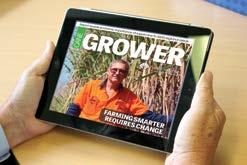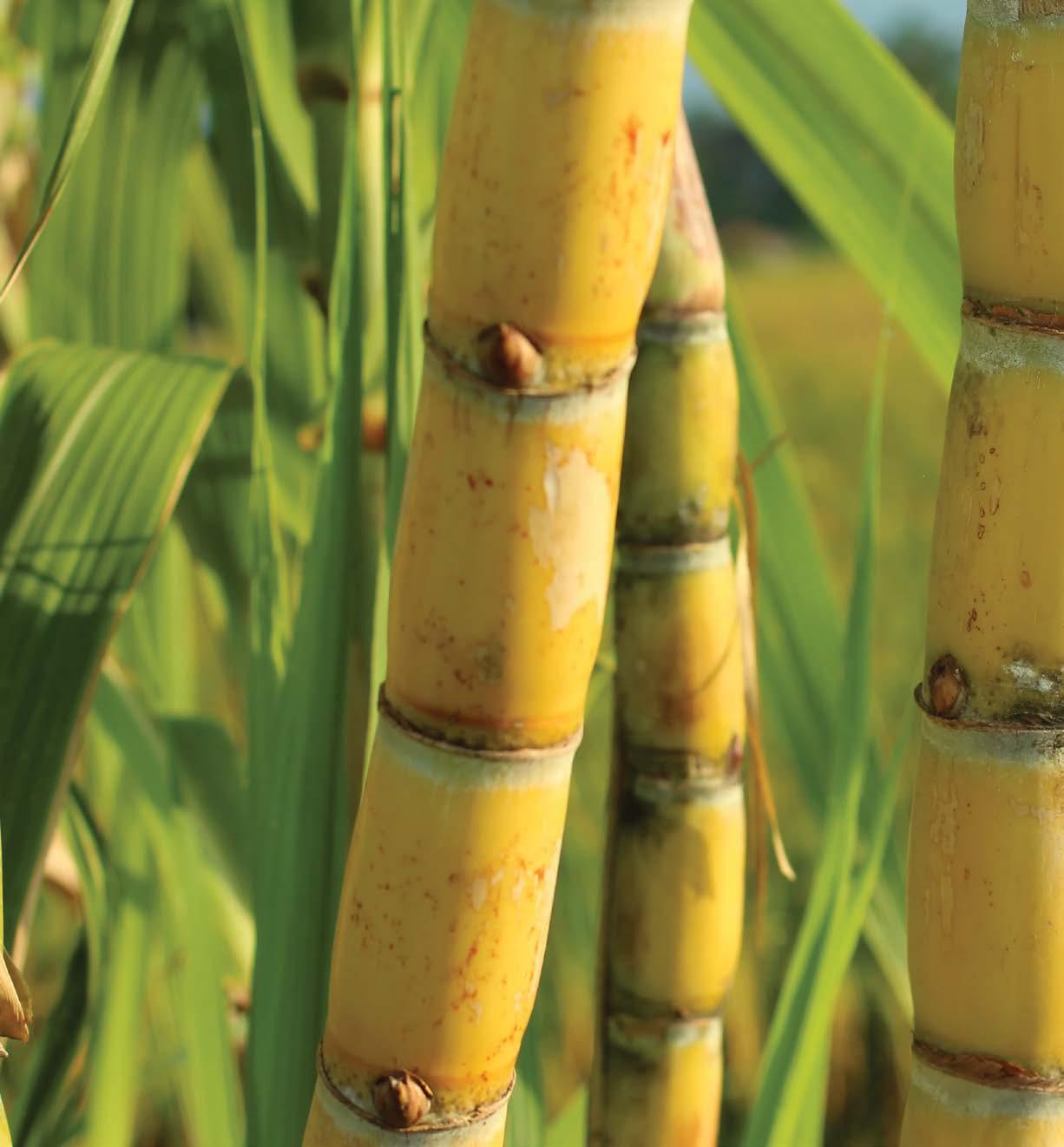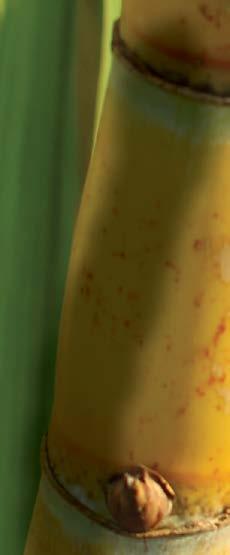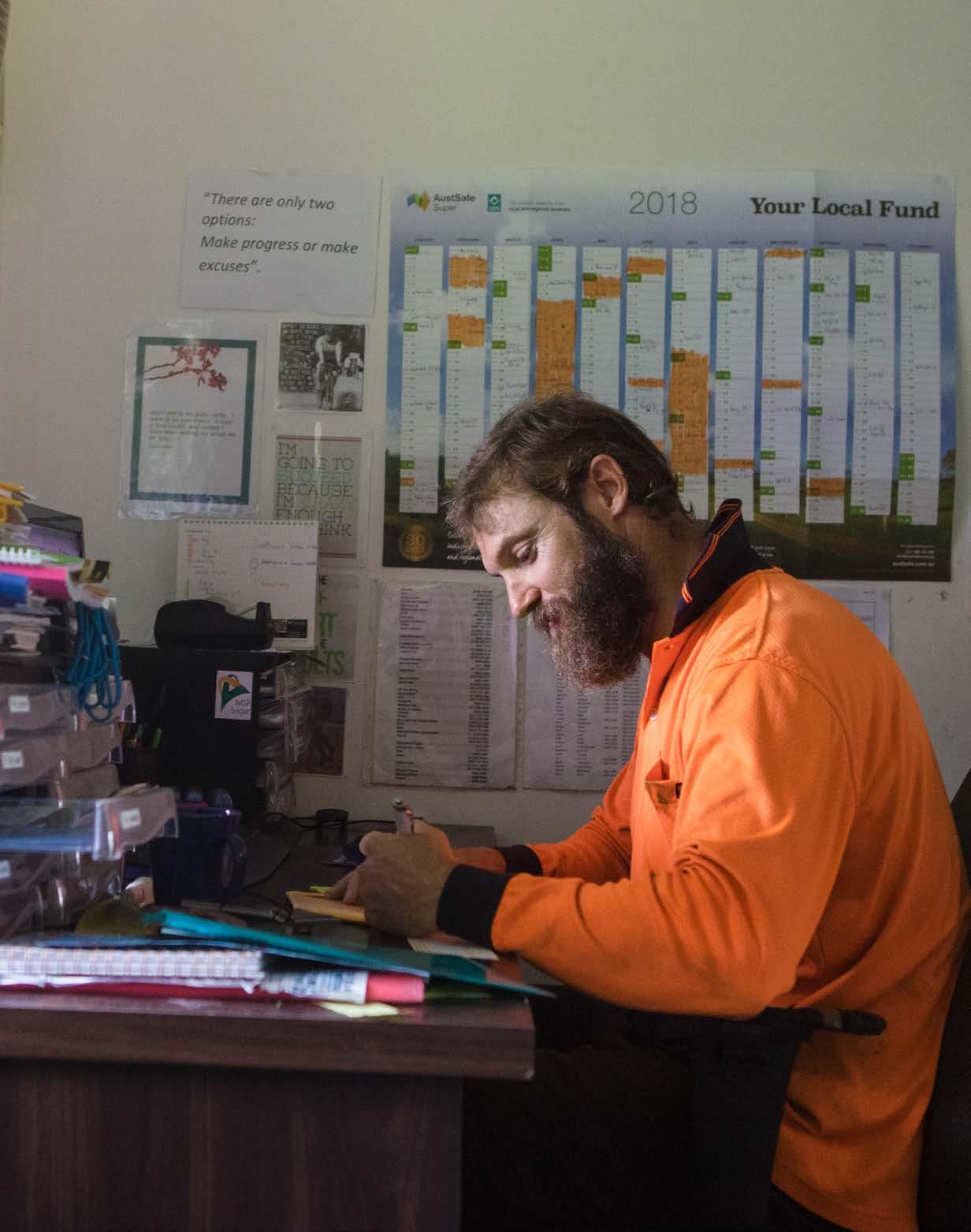




















eNtrench® NXTGEN with Optinyte® technology works by keeping your nitrogen in the crop root zone for longer. To do this eNtrench NXTGEN inhibits the activity of the specific soil bacteria responsible for converting nitrogen into forms that can be rapidly lost from your soil.
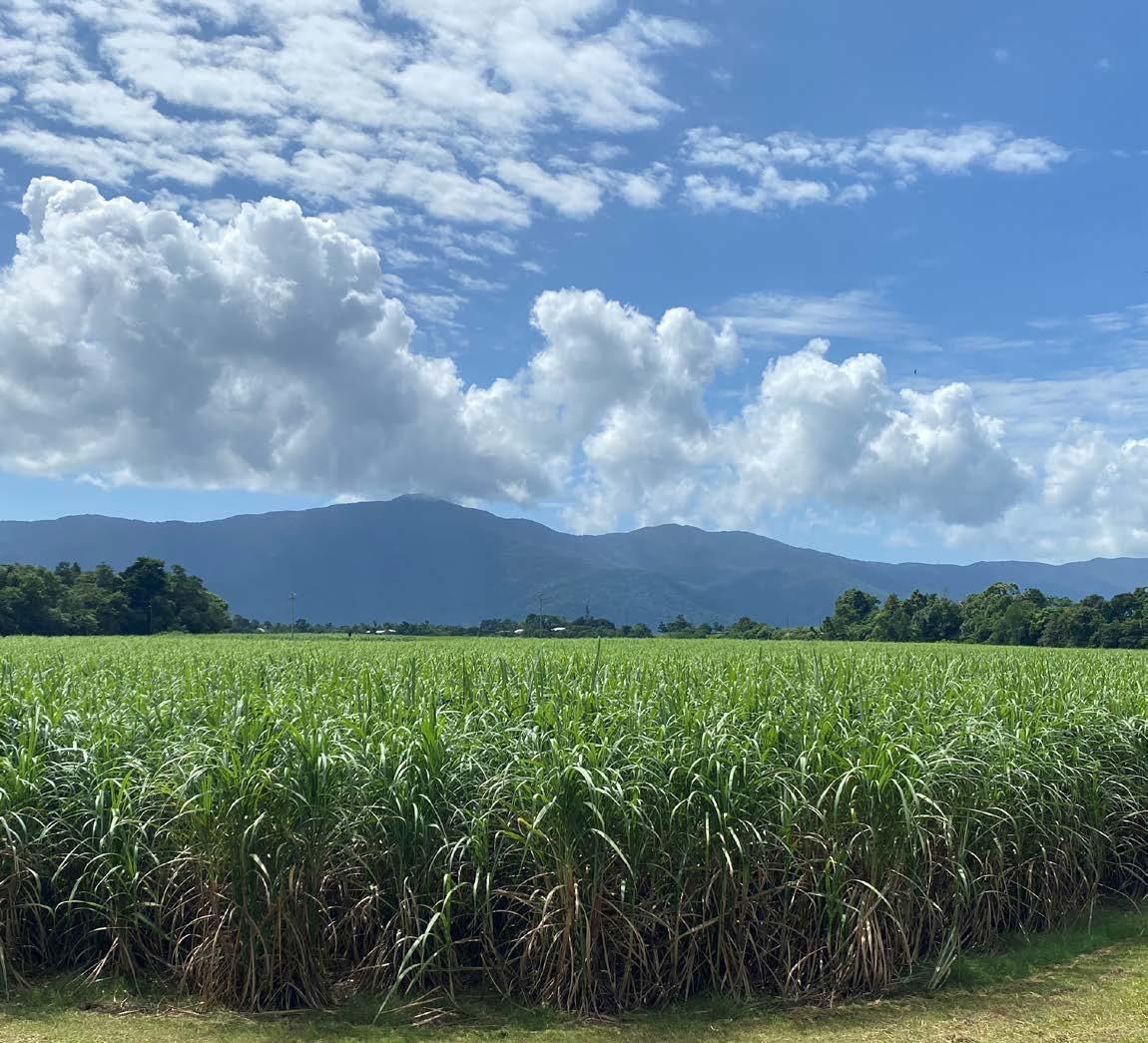
To find out more contact your local territory manager or call 1800 700 096.
label

A new prototype harvesting predictive tool has specialists excited about the potential to assist harvesting best practice.
An explosion in feral pig numbers has Innisfail growers working together to find effective solutions for sustainable outcomes.
Deliberately lit fires on the Tableland destroy crops and cause extra costs but crop insurance will minimise financial losses.
A new resource provides guidance to secure financial sustainability for family-run farms and early communication is key.
Editor: Wayne Griffin
and classifieds: Angela Linhart
appearing in Australian Canegrower do not necessarily represent the
of CANEGROWERS
monthly by CANEGROWERS
Box 1032, Brisbane, Queensland 4001 Australia
94 089 992 969

07 3864 6444
editor@CANEGROWERS .com.au
COVER IMAGE: Bundaberg grower Katrina Chapman, pictured with Amy and Sophie, knows first-hand how important open conversations with all family members is when it comes to succession planning. Read more on page 24.
CONTENTS IMAGE: CANEGROWERS
Tableland Chairman Claude Santucci lost eight hectares of cane in deliberately lit fire. Read more on page 22.

www.CANEGROWERS .com.au
CANEGROWER ISSN 0157-3039
Number
subscriptions for
Australia
(postage

Prior to the Federal Government handing down its interim budget last month, CANEGROWERS CEO Dan Galligan joined other ag industry leaders at a Queensland Farmer’s Federation (QFF) lunch with Federal Agriculture Minister, Murray Watt.
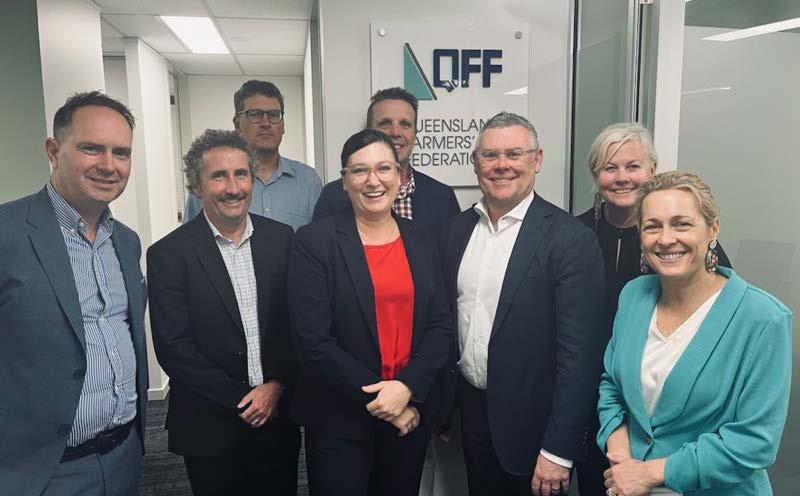
The Minister spent two hours with the small group listening to the industry priorities and forecasting his priorities in the role and the focus on biosecurity and renewable energy in the budget.
CANEGROWERS took the opportunity to emphasis our focus on trade and market access, incentive and recognition programs for sustainability and possible government efforts to assist in workforce development and input cost increases.
Pictured: Adam Knapp (QFF), Dan Galligan (CANEGROWERS), Eric Danzi (East Aust Milk), Sharon McIntosh (QFF), Paul Sloman (Cotton Aust), Federal Minister for Agriculture Murray Watt, Jo Sheppard (QFF), Rachel Chamber (Growcom).
First Cut, the latest video series from CANEGROWERS, was launched last month and is exclusive to members. The series breaks down topical issues and industry challenges through face-to-face interviews with relevant experts.

Episode 1 deals with the Bureau of Meteorology’s declaration of Australia's third successive La Niña event, explaining options for growers who may be concerned about meeting sugar pricing commitments if rainfall stalls the harvest. The video was emailed directly to members earlier and is available on the members page of CANEGROWERS website.
The AgDay photography competition is on again and this year it’s been expanded to include video too!

A prize pool of $5,000 is up for grabs thanks to sponsors Syngenta.
Entrants can submit their photo or video using the link below, capturing innovation in agriculture.
There is no age limit, so everyone is encouraged to submit.
Entries close 5pm AEDT on 18 November. Visit agday.org.au for more information.
Pictured: Prime Minister Anthony Albanese and Minister for Agriculture Murray Watt heard firsthand the challenges and opportunities facing the industry, when they visited Mackay earlier this year.
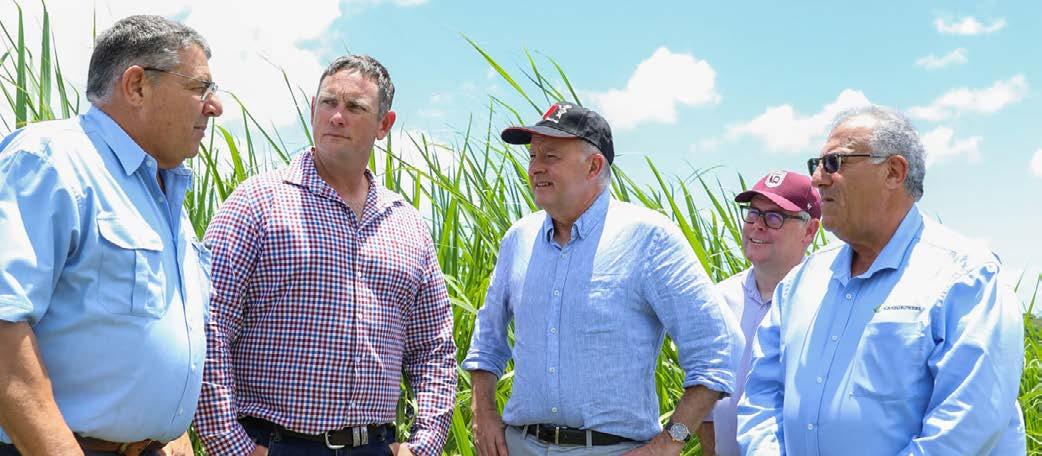
The Albanese Government handed down its first interim budget last month and as expected there was little in the way of new spending commitments for agriculture.
While the budget did deliver on some of the government’s election commitments, such as regional connectivity, it also walked back some commitments, such as additional funding support the Pacific Australia Labour Mobility Scheme to help alleviate workforce shortages.
“A big lick of money ($757 million) to improve digital connectivity in regional Australia is perhaps the budget announcement that delivers the biggest forethought, as digital connectivity will be critical to future ag innovation, so the Government should be commended for this initiative” CANEGROWERS CEO Dan Galligan said.
“Unfortunately, the Budget reveals that Labor’s election commitment to cover worker travel costs under the Pacific Australia Labour Mobility (PALM) Scheme will instead be replaced with an underwriting scheme.
“While the PALM scheme is not the “fix all” for all workforce issues, it is a critical component to alleviate the current crisis in the lack of workers in agriculture, and this change in the budget could indicate that the government doesn’t realise how urgent this issue is.”
The budget was billed, and indeed was delivered as a transition budget sitting after the election win by Labor and prior to the normal budget, which is due for May 2023.
As a result, it largely focused on budget allocation to deliver election commitments and winding back what the Albanese Government views as unnecessary or excessive spending commitments by the Morrison Government. Unfortunately some of the savings come form regional projects.
"There was very limited new funding for agriculture, aside from what was already known as part of the election commitments," Mr Galligan said.
"Additional funding for biosecurity and traceability is an important signal that the new ag minister knows how high a priority this issue is for agriculture."
National Farmers' Federation President Fiona Simson also gave the interim budget a mixed review.
"While this Budget delivers on fantastic election commitments in areas like connectivity, it is also wanting when it comes to some of agriculture’s greatest challenges," Ms Simson said.
"The government doesn't realise just how dire workforce shortages are for agriculture companies and farmers who are desperately seeking to fill jobs."
A 10-year Energy and Jobs Plan announced by the State Government last month could see Queensland’s sugar industry become one of the state’s largest suppliers of renewable energy.
The $62 billion plan includes a $4 million investment to ‘work with industry to investigate options and pathways to expand generation from underutilised biomass waste streams and support technology innovation’.
This, the Plan says, will support industries, such as the sugarcane industry, to modernise bioenergy generation and use waste products for bioenergy production.
CANEGROWERS Chairman Owen Menkens said the industry was perfectly positioned to become a major player in the state’s renewable energy future.
“The sugar industry is already powering regional communities in the Tableland, Burdekin and Mackay with clean, renewable energy, but there is a capacity to dramatically increase the power output of our mills to help Queensland reach the ambitious targets set out by the government,” Mr Menkens said.
“CANEGROWERS is supportive of any programs that either assist, or at the very least incentivise, mills to upgrade their boilers and power-generation infrastructure to improve efficiencies in cogeneration and allow more power to be released onto the grid.
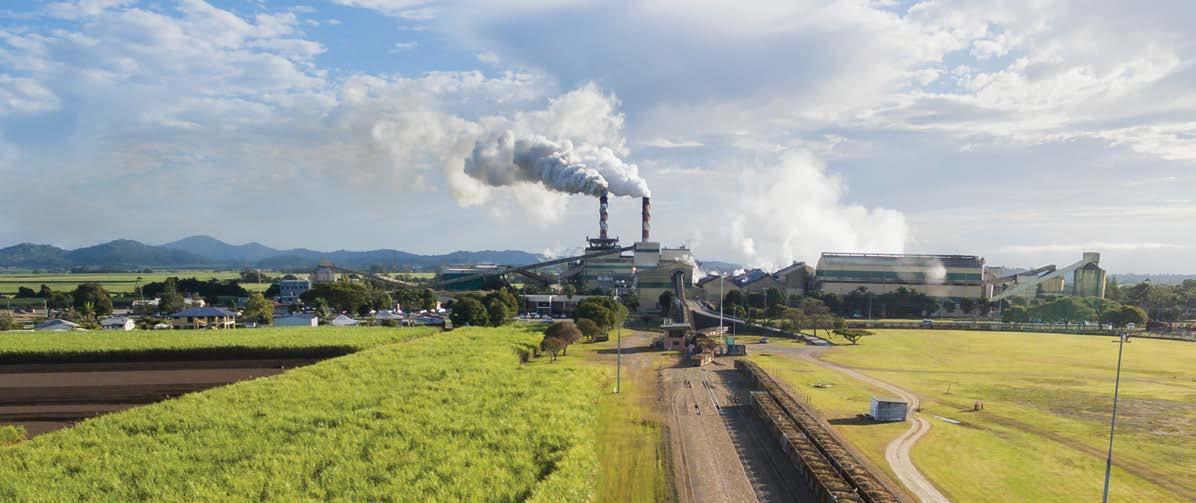
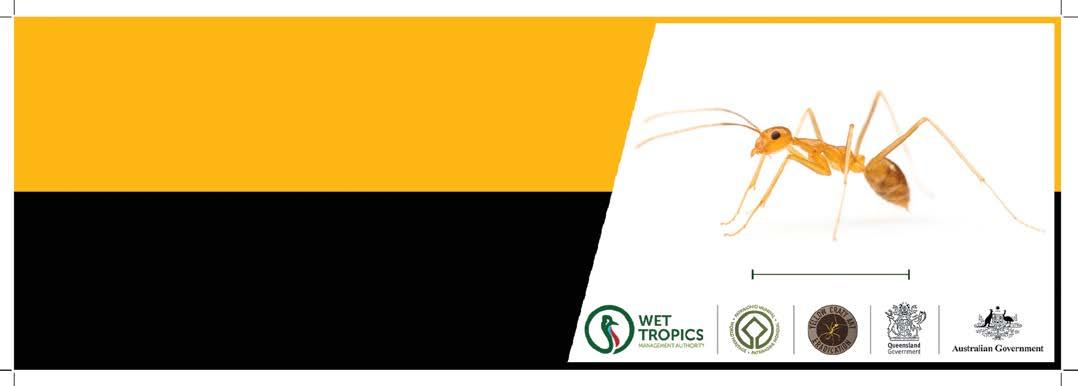
“This is not only good for the environment, it’s also good for the energy market, good for consumers, and it makes our mills more efficient which is good for the industry.”

A recent report by the Australian Sugar Milling Council found that Queensland’s milling sector had the capacity to almost quadruple its current generation from bagasse from 438MW to 1,736MW.
This could see the industry exporting up to 7,588 gigawatt hours of energy a year – around 10% of Queensland’s current electricity generation.
sugar industry is already powering regional communities with clean, renewable energy, but there is a capacity to dramatically increase the power output of our mills."


Over the past few months, CANEGROWERS has joined with other key industry stakeholders to help create a new online magazine aimed at increasing awareness and knowledge amongst high-school students about the wide variety of career opportunities in agriculture.
The Careers in Agriculture magazine, created by Queensland Farmers’ Federation (QFF) and the Rural Skills and Jobs Alliance (RJSA), is targeted not only at students, but also parents, teachers and career advisors.
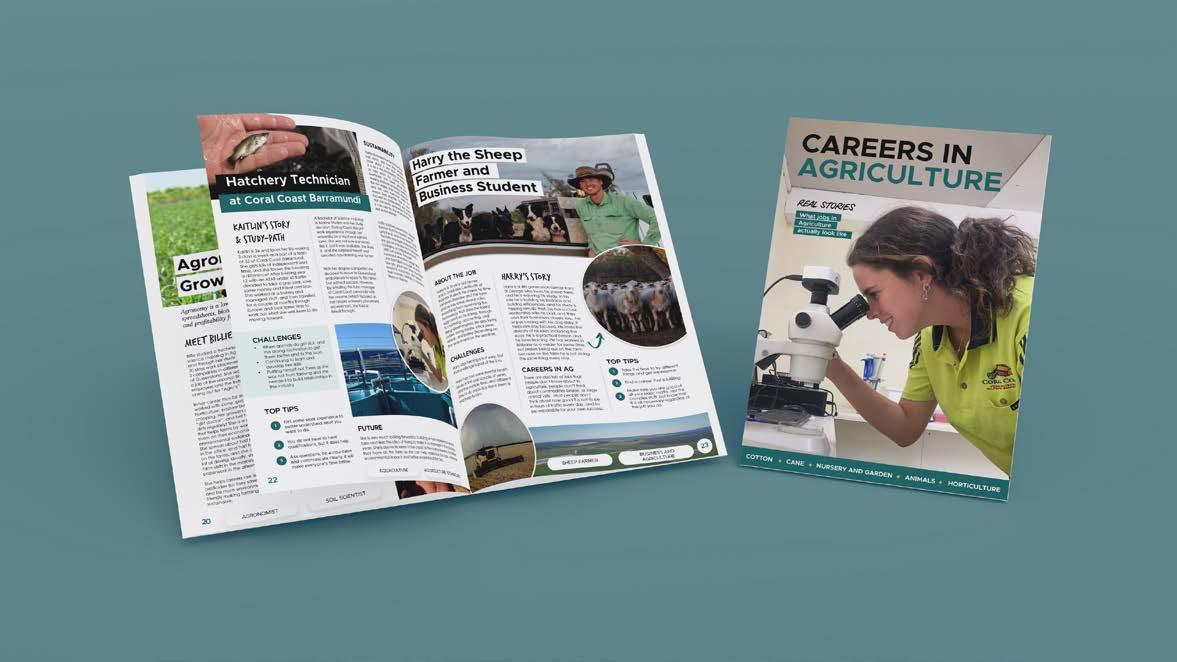
CANEGROWERS highlighted some of the fantastic careers within the sugar industry, including two real life career stories from Jasmine Girgenti, Burdekin Productivity Services Extension Officer and Felicity Atken , SRA Variety Development Manager.
“The Careers in Agriculture magazine provides a much needed resource providing insight into the many agricultural careers and the pathways that are available,” CANEGROWERS CEO Dan Galligan said.
“We are clearly in the middle of an immediate crisis with a desperate shortage of workers in our industry. While we need immediate solutions, we also need to invest in the longterm to attract, skill and retain workers."
“We are clearly in the middle of an immediate crisis with a desperate shortage of workers in our industry. While we need immediate solutions, we also need to invest in the long-term to attract, skill and retain workers.
"We are doing that by taking strategic actions to contribute to the future of our education system, promote and profile the many wonderful careers and to implement industry specific training programs.
“The industry must be proactive and help inform our young people in schools by working directly with teachers, principals, and industry liaison staff to provide resources and knowledge that will provide great career opportunities for kids across the state.”
QFF CEO Jo Sheppard acknowledged that agricultural workforce demand continues to both grow and change, moving towards a more skilled and capable workforce, aware of emerging market and technology developments revolutionising agricultural industries.
“We require new approaches to attract and retain skilled individuals across the sector to ensure its future survival and success”, explained Ms Sheppard.
The magazine was officially launched on Monday 24 October and is now available through the Career Harvest website at: www.careerharvest.com.au/qff-careersinag ■

Aloomba cane grower Tony Rossi has been recognised as an innovating champion of the Wet Tropics, taking home the prestigious Peter Hitchcock Community Champion title at this year’s Cassowary Awards.
The awards celebrate the work of people and organisations who help protect the Wet Tropics World Heritage Area.
Wet Tropics Management Authority Chair, Chrissy Grant , said champions like Tony were helping create greater alignment between the agricultural and environmental needs of the Wet Tropics region.
“Mr Rossi is a cane farmer whose years of hard work with Mulgrave River Landcare have not only seen an improvement to landscapes, but also a shift in the agriculture sector, where the values of agriculture and environmental protection are working together,” Ms Grant said.
“Choosing the nine award recipients from more than 40 nominations was no easy task as each of the nominees are valued and important members of the Wet Tropics community.”

“All of the nominees and award recipients are people who work tirelessly towards not only protecting and promoting the Outstanding Universal Value of the Area, but also helping build resilience into this unique and special place to adapt to the impacts of a changing climate,” Ms Grant said.
Tony has long been an advocate for innovative farming practices. The Rossi family successfully makes and uses their
own compost to decrease their reliance on inorganic nitrogen fertiliser and reduce the risk of nitrogen leaving the farm and entering local waterways.
The compost also improves the condition of their soil, as showcased in the CANEGROWERS Virtual Bus Tour series ‘Composting on a Wet Tropics cane farm’: www.canegrowers.com.au/page/videos



Do
Tungsten
Fe40+ will also weld over old T/C chip. Great app for base cutting discs. Easily applied with a standard MIG machine.
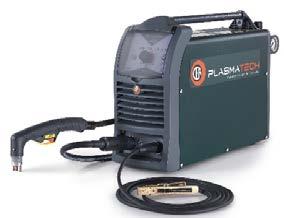
$750 EX GST. 1.6mm x 5kg SP.


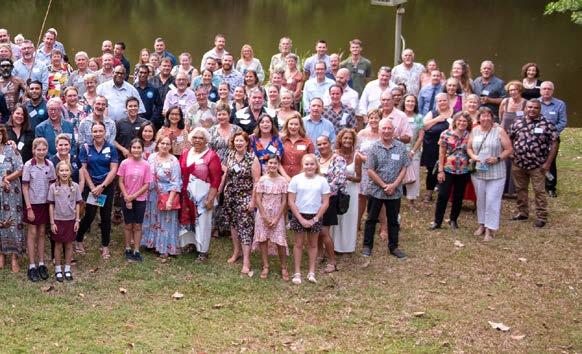
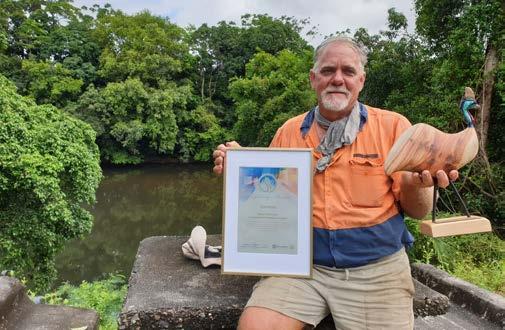
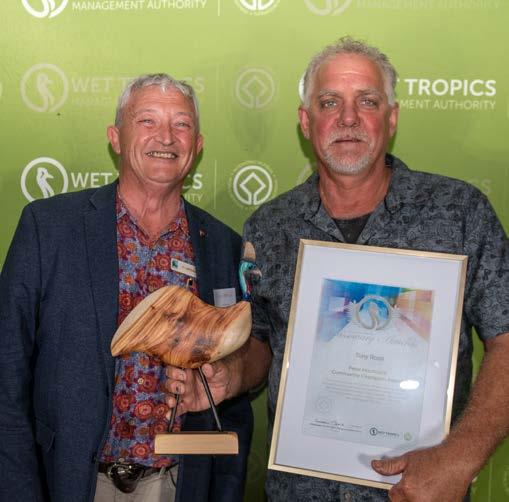

Cane growers across the state have felt the negative consequences of being on the wrong side of the environmental debate.
No matter where you sit on the health of the Great Barrier Reef, the fact is farmers have often been held up as scapegoats and made responsible for managing risks to water quality.
This started over a decade ago for our industry and the regulatory requirements have continued to expand.
Meanwhile, requirements on other industries, such as horticulture and cattle, are only just coming into play this year.
Thankfully cane growers have not stood still. The commitment shown by over 700 producers to become certified under Smartcane BMP has delivered not only recognition from government but shielded them from compliance audits.
This work and the recognition of Australia as a sustainable sugar supply chain has shown that our industry is getting in front of this environmental debate.
Smartcane BMP and growers being proactive in adoption is delivering regulator and market-based recognition.
The industry has caught up and now we must use these efforts to lead the inevitable next round of demands.
The decision by the Australian Government to commit to achieving a net zero emissions target by 2050 and 43% by 2030 means that the broader economy is now shifting to respond.
Energy, mining, manufacturing, processing companies and financial institutions are all shifting to be able to report how they contribute either positively or negatively to the country’s pathway to these targets.
By doing this now, they may avoid a regulatory or compulsory framework that future governments impose on high emitting industries.
This is where it is important for all of us in agriculture. Farmers rely on many of these global companies for either inputs or for marketing or processing their produce.
Farmers must not wear the costs of these companies adapting to report on their contribution to environmental, social or governance (ESG) objectives.
The companies involved often gain value for such efforts and this value must be shared with farmers who, in the end, deliver the sustainability that others are so keen to dine out on.
For CANEGROWERS, the efforts of the past 10 years have positioned us to be at the forefront of this new wave of environmental demands that are driven by community and market expectations.
We must stand up and protect the profitability of farmers so they receive the recognition, value and benefits of delivering the sustainability that the world
Thankfully, with Smartcane BMP and a new approach to the bioeconomy in the Sugar Plus roadmap, we have strong foundations to build upon.
Do you want to determine and understand your business costs of production & profitability?
Do you have tools to determine what sugar price you need to cover your costs of production & make a profit?
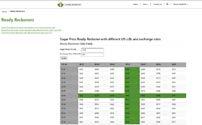
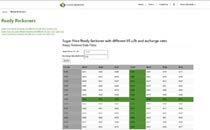
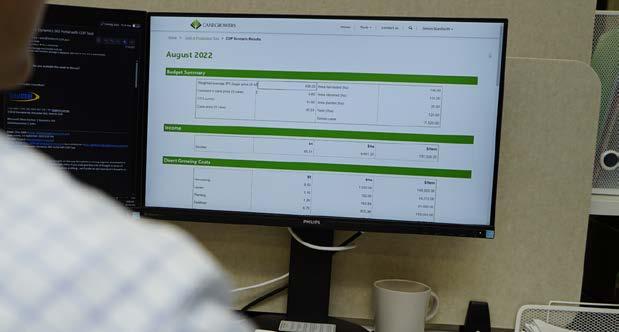
Do you want to better understand risk management & in particular manage the risk with volatile world sugar prices
then maybe you need to consider attending one of the highly successful Business Essentials workshops in 2023
We will have workshops across the industry in 2023 from February to June, places may be limited, register your interest now!
During 2022 the Business Essentials workshops growers told us they understood how important professional development is to their businesses but struggled to find the time to commit to the two full day face-to-face workshops.
The workshop content topics have been broken into a mix of online learning modules, that you will be able to access at your convenience providing flexible self-paced scheduling and opportunities to refresh or revisit training. This will be followed by a full day practical hands-on interactive workshop run by highly experience farm economists and sugar marketing and risk specialists who have a wealth of knowledge.
You will walk away armed with:
• great tools to understand your business finances
• a process to assess and prioritise your risks with options to mitigate them
• a process to assist in determining what a good future sugar price is for your business.
The costs of the course and workshop is $110 (incl GST) per participant and all cane growers, family members and farm employees are welcome
We will have workshops across the industry in 2023, so register your interest by scanning the QR code below, contact your district office or visit the Business Essentials page on the CANEGROWERS website.
This program is jointly funded through the Australian Government’s Future Drought Fund and the Queensland Government’s Drought and Climate Adaptation Program.
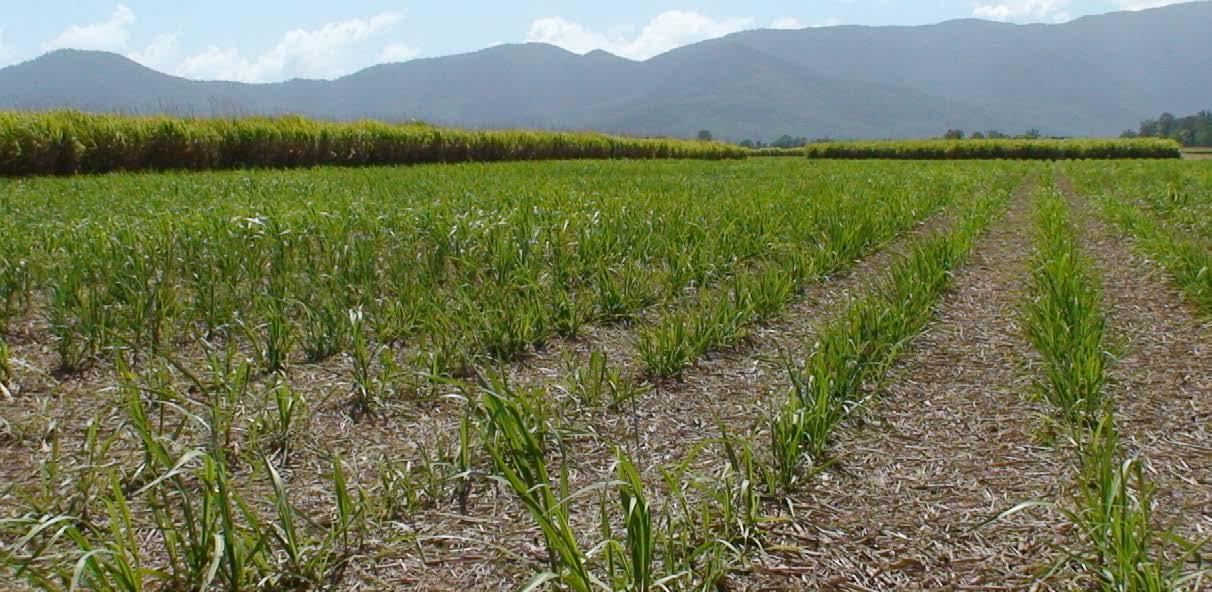 CANEGROWERS BUSINESS ESSENTIALS professional development for growers
CANEGROWERS BUSINESS ESSENTIALS professional development for growers
SRA District Manager Northern and Agricultural Machinery Specialist Phil Patane and Department of Agriculture and Fisheries, Queensland (DAF) Economist Brendon Nothard are excited.
From almost five years of investigations and trials and sitting down with hundreds of contractors and growers to capture and analyse thousands of hours’ worth of data, they have a new mate that they can’t wait to introduce to the industry.
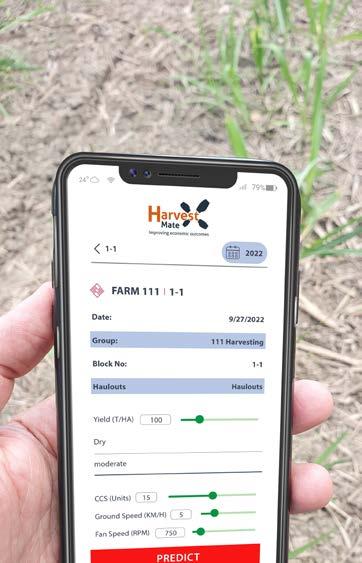
“We’ve been working together on the concept of a Harvesting Predictive Tool (HPT) since 2019,” Phil said. “And we are excited that we are now in a position and on schedule to take the newly named Harvest Mate online platform and smartphone app prototype out to selected harvesting groups and growers for testing.”
The app has been created to fill an identified and critical knowledge gap in the sugarcane industry.
“In 2019 SRA had 148 responses to a survey that asked growers and harvesting contractors about their harvesting best practice. We wanted to understand who was following best economical practice and from those that weren’t, what was stopping them,” Phil said.
“More than 68% of survey participants told us they weren’t adopting the best economical practice because they didn't know what it was. More specifically they didn't know the cost of harvesting versus the yield benefits when changing from their current practices,” Phil said.
(Below right) Phil Patane and Brendon Nothard are excited to be testing the prototype of the Harvest Mate app. (Centre) Growers were engaged in the development of the Harvest Mate app at recent SRA field days. (Below) The free Harvest Mate app will be launched for use by the Australian sugarcane industry in early 2023.
“But the encouraging output from that survey was that the same group told us they would consider the adoption of a harvesting tool; if there was one that they could trust and could easily learn to use and adopt.”
“Through running trials on properties from Mossman in Far North Queensland, all the way south to Hardwood in NSW, we’ve spoken to hundreds and hundreds of growers and contractors about how they harvest; and gathered as much data as we could,” Brendon said.
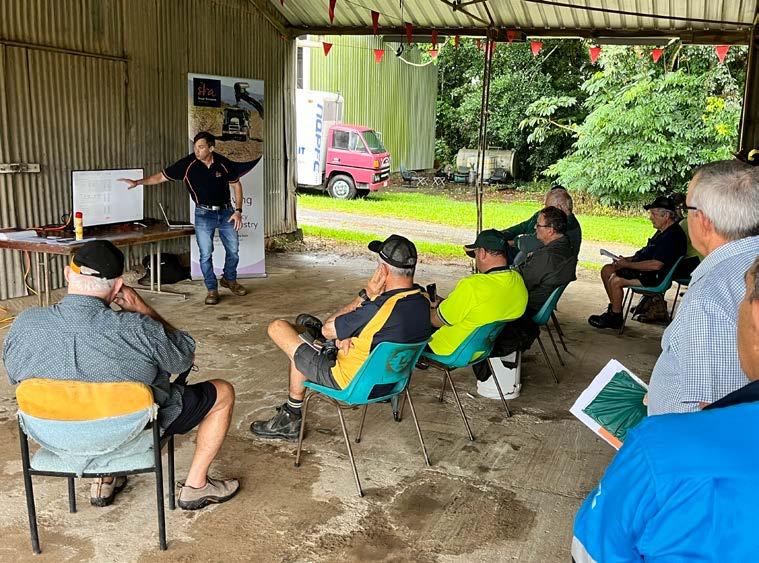
“We’ve captured a range of different scenarios and machine types, down to the size and length of billets and extraneous matter levels. We wanted to understand how the harvester deals with the cane for different yields, different conditions and at different flow rates.”
Harvest Mate users will be encouraged to set up their unique profiles online during the slack season.
“At this time the grower gets to estimate the net benefit or how much more he might pick up in $$ per hectare when changing to different harvester settings,” Brendon said.
“Contractors can enter their own information and review outputs to ensure the predictions are relevant to their own businesses.
“Then when the grower, or the contractor is out in the field and they want to refer to the data to find out the most economical way to harvest a particular crop, or want to quickly change some inputs and settings, that can be done easily via a smartphone.”
“It’s been developed to be user-friendly, and we hope that’s reflected in the name but more than that, the app should be seen as a mate helping you out,” Phil said.
“If you try to reduce harvesting cost by affecting yield, then that’s not economically viable and vice versa. Trying to reduce cane loss by significantly affecting harvesting cost is not economically viable either. The optimal is finding a balance between cost of harvesting and yield change with different practices.”
Brendon added that the app is based largely on data gathered from the field and uses cost benefit economics.

“It’s the only tool out there that takes into account the true economics in relation to both real revenue changes against actual cost of harvesting,” he said.
“We know this is something growers have understandably struggled with in their planning. In the past, our data gathering has involved DAF economists spending many hours with trial participants gathering information in a detailed economic spreadsheet to achieve the same results the app provides. But, with the app it requires minimal input in a fraction of the time.
“Of course, if we get a new machine on the market, we will have to test those against the existing data and see if they behave similarly. But we are comfortable Harvest Mate will accommodate most situations for our existing machines and cane regions. We believe we have covered our bases around yield, varieties and most conditions,” Brendon said.
The Harvest Mate app is now at the prototype stage and will be tested in several demonstration sites by the end of the year. Keep an eye on SRA’s website and eNewsletter for advertised demonstrations in the north of the state.
From the new year a series of harvesting forums are planned with a full launch and release of the tool to everyone in the industry for the 2023 season. The tool will be free-to-use for the Australian sugarcane industry.
SRA acknowledges the funding contribution of the Queensland Department of Agriculture and Fisheries for this research activity.
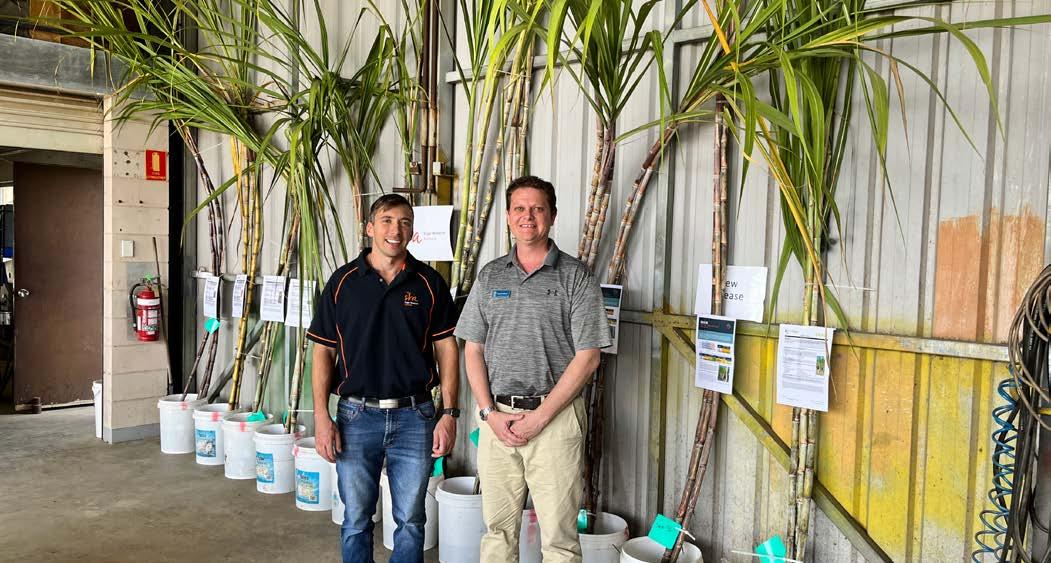
Unfortunately, with rain continuing to fall in many areas and poor mill performance delaying the crush in others, we are looking at a late finish right up and down the coast.
It will be a struggle to get the cane off this season and this will result in a lot of anxiety for growers, contractors and mill employees.
The sugar industry is unique compared to other agricultural industries in that growers and mills need to work together to get the cane off.
The season length is essentially dictated by the time it takes the mill to crush the cane, plus any downtime for wet weather.
Growers and mills know that equity needs to be maintained across the district.
While many methods have been employed to try to achieve this equity, the best way remains clear and transparent communication between grower representatives and the mill.
Equity is particularly difficult to maintain in these wet years, especially when the rainfall is sporadic and disproportionate across the district.
That is why transparency and trust between growers and the mill are very important in allowing us to get the cane off.
I understand why growers get frustrated, but it is important that we remain calm and put our best foot forward to get the harvest season completed.
Given the pressure everyone in the industry is under, it is important that workplace safety remains paramount in our minds going forward.
Last year, CANEGROWERS released a Workplace Health and Safety guide designed specifically for sugarcane farms.
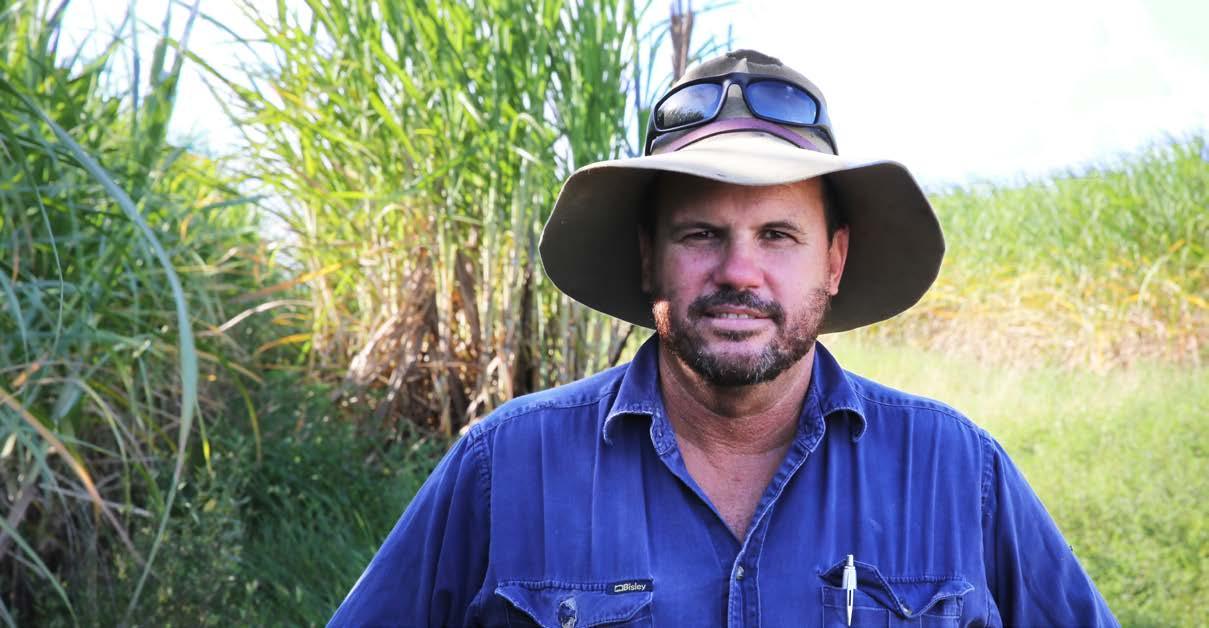
We also have guides to help decision making with regards to the laws around road usage and moving agricultural equipment on public roads.
Further, we have developed guidelines around the hauling and loading of cane.
All of these resources are available through the member portal on our website.
There is another important aspect of safety that we need to bear in mind. That is the interaction between growers, contractors and mill staff at delivery points and across the district.
It’s important that everyone is vigilant when operating in these areas. I feel transparency and respect are critical when dealing with each other to manage these issues.
We all want to arrive home safely after a hard day at work and we need to be innovative in how we look after the safety of everyone in the industry.
I look forward to working with mills to improve safety through the adoption of new approaches and technology, so we can all work together for a better outcome for all.
While we all individually have a responsibility to think and act safely, there are resources out there that can help with safety issues. But we must work together to see these resources used to best affect.
Given our workplaces are also our homes, farmers are at the frontline when it comes to concerns about safety.
CANEGROWERS members automatically have access to crop insurance cover as part of their membership. The policy can provide cover for loss of crop due to accidental fire, transit and hail incidents.
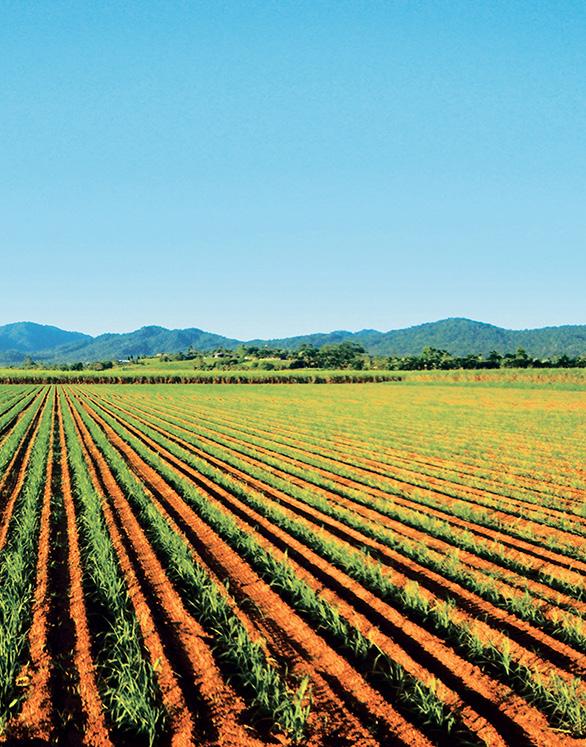
As an explosion in feral pig numbers causes crop losses across sugarcane districts, growers in Innisfail have banded together to fight back.
Innisfail cane grower Alan Colgrave reckons the number of feral pigs on his farm has doubled in the past 18 months. He estimates they’ve led to the loss of a quarter of his yield this harvest season.
“I’ve seen paddocks when we were harvesting that have had 50% plus damage,” Alan said.

“I’ve been trapping, baiting, shooting and I’ve got a hunter using thermal imaging for shooting at night.

“Since the beginning of crushing, I’ve taken 36 pigs off the farm but that doesn’t include those we were baiting.
“It’s much worse than in previous years. There’s still multiple pig sightings every time I go down the farm.”
Alan isn’t alone, with growers across Far North Queensland reporting similar stories.
While exact feral pig numbers aren’t known, the population explosion is evident in the destruction.
The animals dig up the ground and chew cane within paddocks, leading to major productivity losses.
In the Innisfail region, pigs have destroyed entire blocks in some cases, with damaged crops deemed not worth harvesting.
A small survey of just 20 growers in the South Johnstone Mill area forecast an estimated crop loss of more than 20,000 tonnes across 1,200 hectares this season.
That equates to an economic loss of more than a million dollars, or an average of over $50,000 per grower.
Those figures don’t take into account the lower sugar levels of crops still worth harvesting, the increased
weed pressure caused by open canopies, or the environmental cost in what is a region bordering the Great Barrier Reef Marine Park.
Alan’s neighbour, Phil Campagnolo, has also seen plenty of damage.
“A sow will have a litter of six to eight and that happens every three or four months and they’re making a bloody big mess,” Phil said.
“All my drains have been dug up and before I go in and fertilise a paddock it’s all dug up and after I fertilise they dig it up again and after I rip they dig it up again.
“They’re not eating all of it, they’re stomping it into the ground. I’ve lost about 1,000 tonnes on a 4,000-tonne farm.”
Traditionally, managing feral pigs in the region has primarily been the responsibility of landholders. However, with populations increasing to levels beyond what individual growers could counteract, CANEGROWERS Innisfail identified the need for a coordinated response.
It partnered with the Cassowary Coast Regional Council’s Feral Pig Oversight Group (FPOG), which was initially focused on stopping pigs spreading spores of the destructive banana disease Panama Tropical Race Four (TR4) throughout the region.
“The cane industry went to those meetings and said this is a real problem and we took the data to them,” explained CANEGROWERS Innisfail Grower Services Manager, Debra Telford .
“There was power in those numbers. The group decided that rather than being about TR4, it needed to be about feral pigs in general across the whole district.”
A pilot cluster baiting program was developed involving four neighbouring cane growers in the New Harbourline area near Mourilyan, south of Innisfail.
Alan and Phil were involved, along with CANEGROWERS Innisfail Chairman Joseph Marano
“I’ve lost about 1,000 tonnes on a 4,000-tonne farm.”
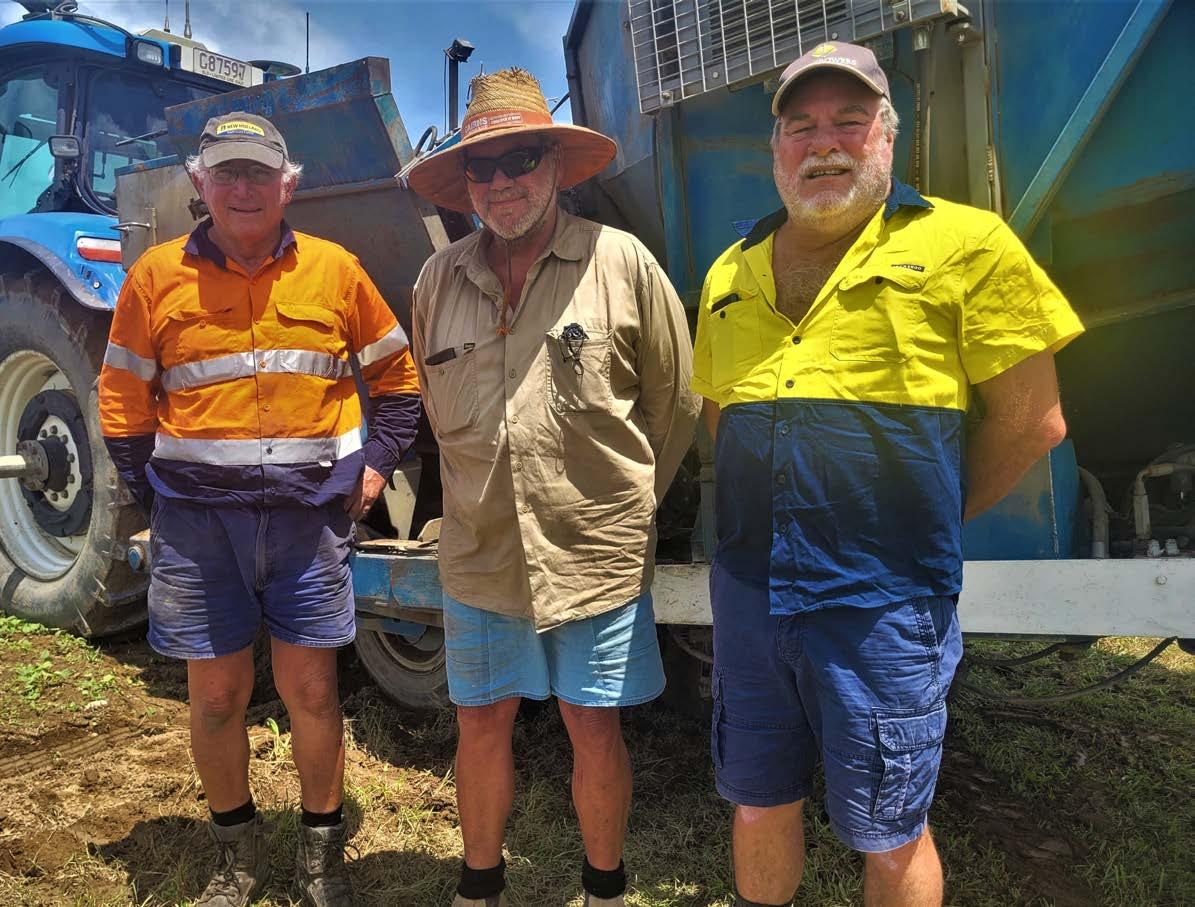
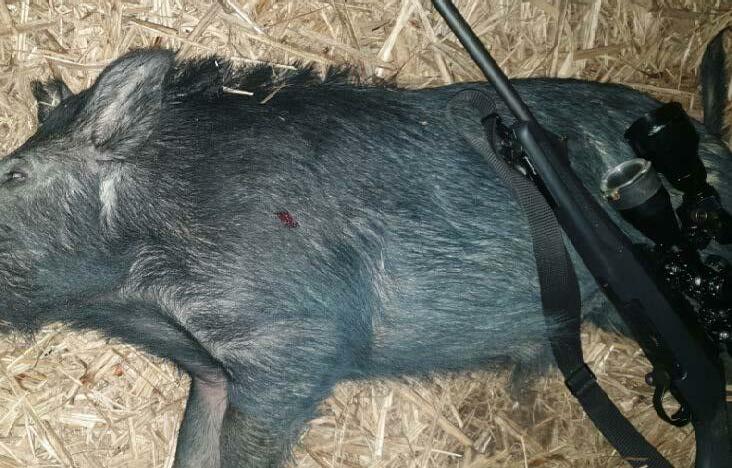
“Growers have left the industry because of pigs,” Joseph said. “We haven’t had successive good years where growers have money in the bank for fencing.”
“When it affects your income, it’s a big driver for change.”
The cluster program required the approval of a new procedure for 1080 application within the Council area. Previously, the poison was supplied to match the quantities of pigs captured by video footage. Under the new operating procedure, the rate was determined by how much free-feed the pigs were taking.
Over 30 days, the growers tirelessly took part in a coordinated effort, laying 180 kilograms of laced bananas.
“We were putting ten kilo buckets out and they were just gone,” Deb said.
“Everyone involved put in a lot of effort.”
As the harvest season moved into high gear, the farmers were each spending around two hours per day on the program, which also included checking sites each morning and afternoon and collecting photographic evidence to upload to the Centre for Invasive Species’ FeralScan app (pictured)
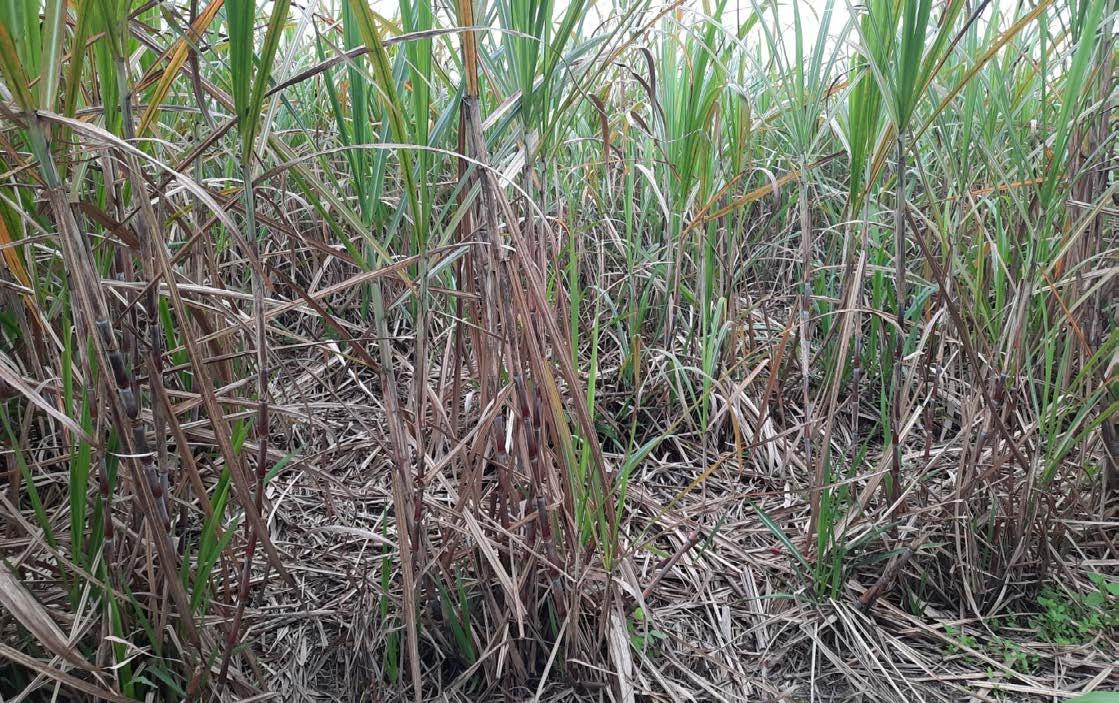
They followed up with an aerial shoot, which took out an additional 20 pigs.
Was it worth the effort? According to Deb, it’s difficult to quantify.
“There was definitely evidence of dead pigs, but did we reduce the damage? No,” she said.
“So, was there a return on investment? I don’t know.
“It was designed as a pilot to see what worked well and what didn’t work well because no-one could really tell me what landscape management baiting was, there was no case study to be guided by.
“Also, the timing wasn’t right for us as an industry because we were in the middle of the crush. No-one could tell me when the right time was, but damage was being sustained, pigs were being seen.”
Deb said a long-term solution will require the appointment of a dedicated staff member to coordinate feral pig control across the region.
“The requirements for general baiting include the establishment of motion cameras for determining whether there are off target species, as well as exclusion devices and we all understand why but it’s a full-time job and then you’re not being a farmer,” she explained.
“You need a dedicated staff member but that staff member doesn’t need to be the doer, they need to be the coordinator.
“The hours I put in were ridiculous coordinating baiting requests as well as assisting with picking up and dropping off the bait.”
Grower Alan Colgrave agrees, but reckons aerial shooting is most effective.
“My view is unless we are shooting large numbers of pigs out of the hotspots from a helicopter, all the rest of the controls are like one step forward, two steps back,” he said.
“Any farms that border riparian areas or unmanaged land are copping the brunt of it and need to be the focus, but the pigs are now moving even further afield than that.
“Once the season ends is the time to take real action.”
“When it affects your income, it’s a big driver for change.”
There are renewed calls to monetise Queensland’s feral pig problem by making wild boar meat exports more viable. Andrew Varasdi is a strategic advisor to Ipswich-based Game Meat Processing and says wild boar products are in high demand in Europe. The company’s major markets include The Netherlands, France, Belgium, Germany and Czech Republic.
However, he said feral pig harvesters need access to the National Parks where pigs live. “There is a growing and increasing demand for wild boar meat in Australia and globally and there are thousands of harvesters available to help,” he said.

“Through trapping, wild boar can be harvested with almost no impact or risk to public land, native animals or fauna and with a very small cost to the government compared with environment and economic benefits that commercial harvesting offers.”

DID YOU KNOW? 2.3 million
Source: Queensland Government
The number of feral pigs estimated in Queensland in 2021
Brazil Wet weather has slowed harvesting over the last month. To date, 432 million tonnes of cane has been harvested and 26.3 million tonnes of sugar produced at an average sugar mix of 45.5%.
India
The market is waiting on confirmation of the Government’s 2022/23 season export allowance, with 6-8 million tonnes expected. After a favourable monsoon, 36-38 million tonnes of sugar is expected to be produced.
Thailand Thai sugar production is expected to increase year-on-year after a healthy monsoon provided optimal growing conditions as well as strong ICE 11 price incentives.
After floating around a net-zero position for most of the month, speculators pushed out to a 46,000 net-long position as of 11/10/22. There is high risk of this position being sold off (liquidated) due to the weak macroeconomic environment.
Currency Concerns over high inflation and interest rate hikes in the United States continued to drive the AUD lower, depreciating to as low as 61.70 US cents

The outlook ratings above are in relation to AUD/tonne sugar prices. A bullish outlook is considered positive. A bearish outlook is considered negative.
$US0.6272 -$US0.0377
112.88 +1.53
7.21 CNY +0.13 CNY
3,665.78 -92.21
2.60%
is a whole-of-season ICE 11
as of 21.10.22,
on
5:1
ratio for the 2022 Season, and 1:2:2:1 ratio for the 2023, 2024 and 2025 Seasons.
Disclaimer: This report contains information of a general or summary nature and is based on information available to QSL from many sources. While all care is taken in the preparation of this report, the reliability, accuracy or completeness of the information provided in the document is not guaranteed. The update on marketing and pricing activity does not constitute financial or investment advice. You should seek your
read the QSL Pricing Pool Terms, which are contained on QSL’s website. Nothing contained in this report should be relied upon as a representation
financial
to
that
outcome will be achieved. Information about past performance is not an indication of future performance. The information in the report is current
as the information is based on many assumptions and is subject to uncertainties inherent in any
QSL does not accept any
at
any
for
decisions
taken by that person with respect to any of the information contained in this report.
The highest QSL grower-managed pricing levels achieved to date (all gross price actual/tonne) are:
• 2022 Target Price = $660 / IFC $660 (Mar23)
• 2023 Target Price = $600 / IFC $605 (Jul23)
• 2024 Target Price = $560 / IFC $570 (Jul24)
• 2025 Target Price = $540 / IFC $545 (Jul25)
ROLL ADJUSTMENT: Growers with unfilled 2022-Season Target Price Contract orders are reminded that due to the positive roll adjustment for the season to date, unfilled orders now only need to reach their set target less $4.67 to be filled.
MONITOR COMMITMENTS: Growers using QSL Direct can track the delivery of their sugar tonnage against their committed pricing via the QSL App or portal. This information is under the Delivered and Remaining Tonnes section within the ‘More’ tab for the 2022 Season on the app, or on the reporting page for the current season within the portal.
ADVANCES INCREASE: QSL’s Standard Advance rate increased by 5% to 70% from 19 October. The new payment rate reflects indicative pool values as of 26 August 2022 and represents a $42/tonne IPS net increase to the QSL Standard Advance Rate Default Payment.

The Indian Government has traditionally provided a subsidy to Indian mills who wish to export sugar, in an attempt to protect and maintain high domestic prices for sugar sales.
After a strong monsoon which has provided optimal growing conditions in India, another record crop has been forecast for the upcoming 2022/23 season, leading to the question, “How much sugar will India export this season?” being asked by many ICE 11 market participants. Rumours have been circulating, but the Indian Government has not yet made an announcement on the export quota for the upcoming season. It is expected that India will need to replenish some of its domestic stocks after last season’s large export program, leading forecasters to estimate anywhere between 6-8 million tonnes of sugar exports, possibly in two tranches (one early in the season and another later in 2023).
The Indian Government will likely deliver no export subsidy for the 2022/23 season given that the ICE 11 world sugar price has maintained its strong values. However, the ICE 11 price must be higher than the domestic prices that sugar mills can sell their sugar at domestically in order for mills to be incentivised to export. It is expected that the prompt ICE 11 contract will likely need to trade between 18.40-19.30 USc/lb before exports will be more attractive than the domestic price available to Indian mills.
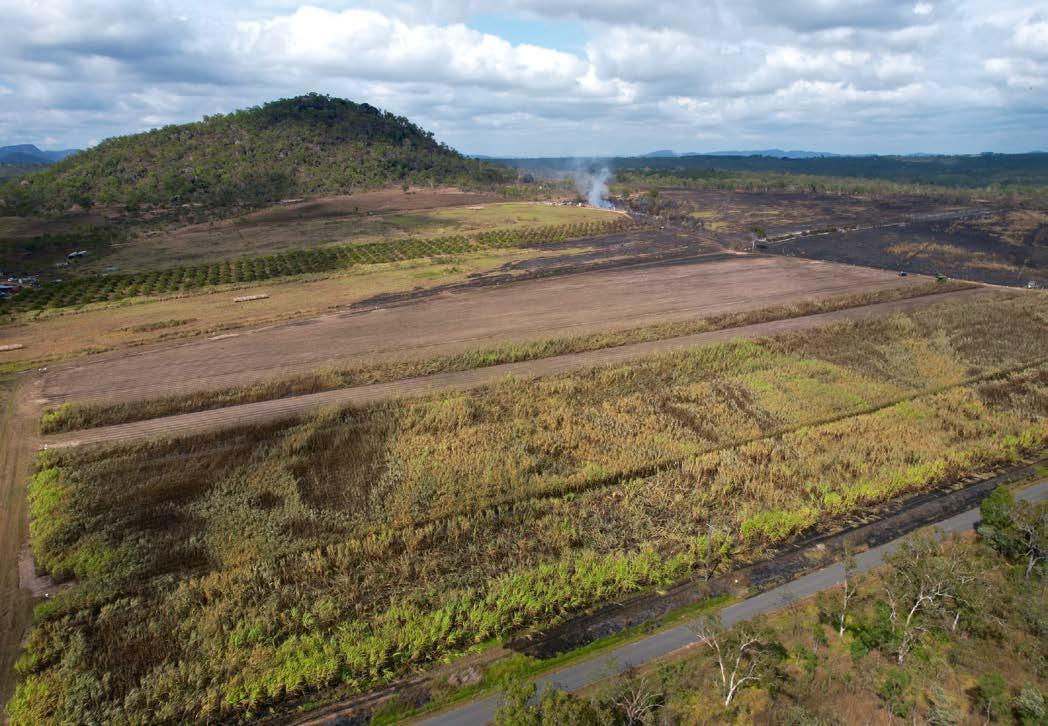
CANEGROWERS Tableland Chairman Claude Santucci (pictured) lost eight hectares of standing cane and two hectares of trash blankets in the blaze.
Claude has two sugarcane properties on the Tableland, but it was the smaller Chewko property that was affected.
“We lost eight hectares of standing cane and about two hectares of trash blankets that were on a cane paddock that had already been harvested," Claude told Zoe Thomas , reporter for the North Queensland Register.
The publication reported a 37-year-old Chewko man faced court after he allegedly lit multiple fires that destroyed crops around Mareeba, Biboohra and Chewko in early October. Police charged the man with 12 counts of setting fire to vegetation.
The cost to Claude’s business is not just the disappointing loss of the crop but there will be extra associated costs due to the loss of cane trash blankets.
"I will incur extra expenses in the sense that because all the trash has been burnt, now that I've harvested, I don't have a trash blanket there to protect moisture and to hold back weed control," Claude said.
"My extra expenses will include extra waterings and herbicide control to get this new crop away.”
CANEGROWERS Insurance Regional Manager Helle Cook said incidents like this is when it is good to know that CANEGROWERS members have access to crop insurance in the event of a fire that was not planned.
“In this case the fire occurred during harvest season and swift action meant that the cane was harvested and off to the mill the following day. Therefore the loss, if any, will be minimal,” Helle said.
“In other instances a fire or hail event may happen out of season and the damage to crop result in subsequent losses. This is when crop insurance can kick in and help minimise a financial loss.”
A CANEGROWERS member who experiences a fire or hail event that cause damage to their crop can contact their local district office to start the claim process.
The claim process steps include having the damage/loss assessed by a cane inspector and completing the relevant crop insurance claim forms.
CANEGROWERS are here to help – and knowing a membership includes access to crop insurance brings peace of mind to growers.
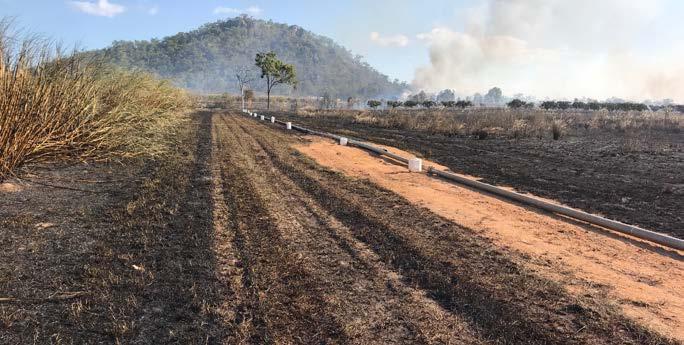
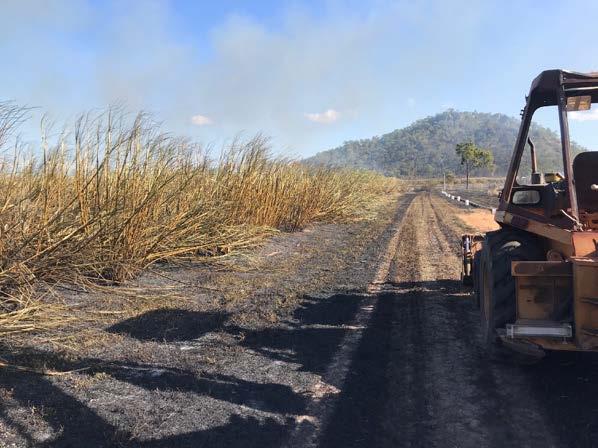
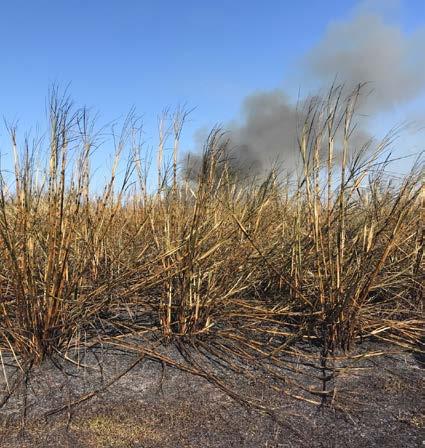

"We lost eight hectares of standing cane and about two hectares of trash blankets that were on a cane paddock that had already been harvested."
Owning and managing an agribusiness is complex, with many considerations required to remain viable, sustainable, competitive, and to meet increasing regulatory demands. Farms may appear to be a unique enterprise when compared to other business types, but when distilled down to tin tacks, a farm is an asset that must perform essential financial functions – often for multiple generations of a family.
Many farming enterprises are intricate and dynamic and if the financial functions of profitability, superannuation, retirement, and transfer of management and ownership are not given a high priority in the business, there could be unintended consequences.
Reliance on unpaid farm labour and farm budget blackholes can and do destroy farming families. While both are accepted as the norm in many farming businesses, they would signal the urgent need for restructuring in any other enterprise.
Financial security is a measure of a person's ability to 'preserve their standard of living and wealth by making independent financial decisions without stress or anxiety'.
Financial security for all parties starts with open and constructive communication, led by the generation or person who owns the assets including all other family members with a stake in the business and ultimately, the owner’s estate.
Financial security underpins a happy workplace.
One of the many challenges to family farming is for all members, particularly women to have an active voice, to be included in the discussions about financial resilience and security.
Research published in 2009 by Queensland Farmers’ Federation (QFF) in a discussion paper - The Financial Security of Farm Businesswomen in Australia by Max Broad, valued women's contribution to agriculture at $23.6 billion, or 49.2% of the output of the industry.
To the same extent as men, women contribute to agriculture's productivity through on and off-farm work, domestic duties and voluntary work. The problem is that for farm businesswomen, factors such as a lack of inclusion in decision-making and control over wealth, an inability to earn personal income, and a lack of institutional recognition, can make them disproportionately vulnerable to poverty in retirement, or after significant events such as bereavement, divorce, and natural disaster.
continues page 26 ►
Pictured: (top) Angela Williams and Katrina Chapman, (bottom) the Chapman family from Bundaberg believe it's important to start having conversations early on when it comes to transitioning and succession planning. Photo credit: Simon Sarra and Joanne Hall.
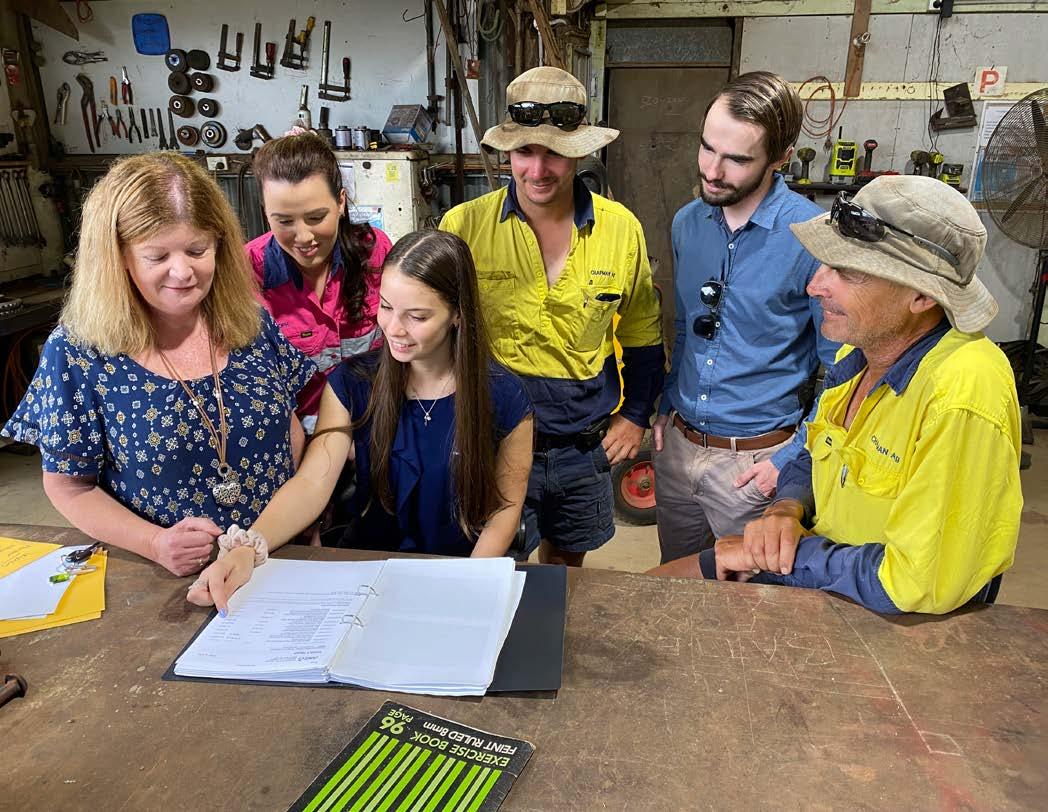

However, there are many success stories of farming with multiple generations and positive examples where women have contributed vision and skillsets that contribute to growth of the farming enterprise.
So, what is needed to ensure the family unit is sustained and transition between generations is successful and smoothly implemented?
Bundaberg growers Katrina and Tony Chapman have firsthand experience working with different generations and extended family members throughout their entire farming history, starting with Harry Chapman Tony’s grandfather who assisted Tony’s father Frank to purchase his first farm in the late 1950s.
Tony and Katrina purchased their first cane farm in the mid90s, and Tony worked his whole farming life with his father until Frank’s ill health meant he was no longer able to be involved in the farming enterprise.
The Chapmans have witnessed and been a part of generational succession on a number of occasions, and the secret to their successful succession from Tony’s parents was having important and open conversations early.
“If succession is to occur, the earlier the process starts the easier it is, as you have time to think things through,” Katrina said.
“Have good discussions with your solicitor and accountant and attend any succession workshops that are being held in your area, as it’s important to understand all the implications.
“Every family is different. Planning is the key, and it should be reviewed continuously.”
The family also works with the next generation. Their son Mitchell is actively involved in the day-to-day operations of their sugarcane farm.
“Mitchell has always shown an interest in farming from an early age and has worked alongside Tony,” Katrina said.
“We’re helping him to develop his own farming enterprise which will gradually assist us to transition into retirement.
“The most important thing is to start early with succession and keep the communication lines open. We are very lucky that we have all been open to discussion. Our daughter Amy who’s not
involved in the farm has always been included and involved in all decisions and discussions regarding succession.”
By involving everyone - those who own the farm, those who work on the farm, those who live or work off-farm, partners/ spouses, children, siblings and seeking out trusted advisors – communication, financial and legal professionals – there is a better chance to navigate the complex and often emotional discussions that can surround these transitions.
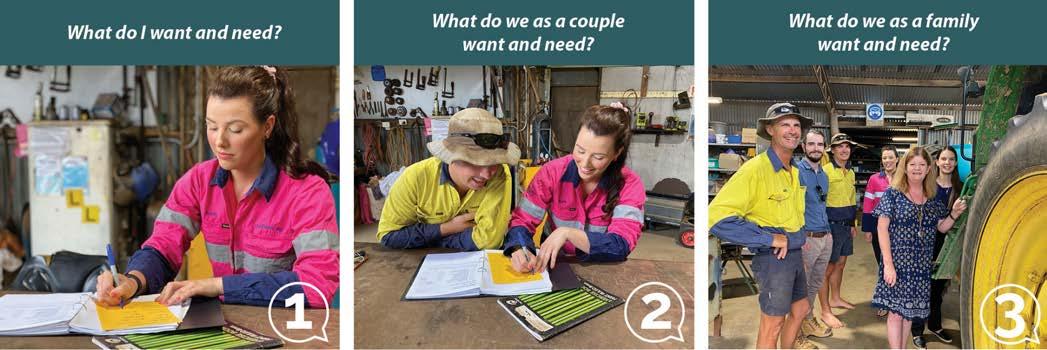
Walking the Wire e-kit is an important resource delivered by the QFF and supported by the Queensland Government. It aims to provide guidance to help rural women take the next step in securing their financial future, particularly where there may have been challenges in prioritising financial security in the past.

To avoid stagnation and disputes, planning and communication are key to transitioning the family farm. According to Walking the Wire there are two golden rules that need to be addressed to ensure that the farm can transition in a manner that does not risk anyone’s financial security:
1. The older generation needs to be able to retire comfortably without relying on the farm as their only source of income; and
2. The next generation taking over the business needs to be satisfied that they are taking over a viable business, once the cost of achieving golden rule number 1 has been determined.
Setting out the above rules is simple. Achieving them can become complicated and fraught with difficulty, particularly where communication breaks down.
Without a doubt, one of the largest risks to family farming businesses is the failure to address succession planning during the lifetime of the generation that currently controls the business assets.
Conversations about the farm’s succession, financial security and retirement and the future can cause angst amongst families and sometimes are avoided when there is always so many priorities that growers deal with in the day-to-day operations on farm.
It is much easier, and less emotional, to avoid these challenges rather than face them head on, but effective communicators address all aspects of running a business and that includes discussions around future finances, transition and succession planning.
Angela Williams , co-developer of Walking the Wire, previous CANEGROWERS Isis manager and now Head of Engagement and Advocacy at Growcom, said this resource provides valuable assistance in ensuring economic security and resilience is part of the family businesses’ success formula.
“Without open and frank discussions around succession planning, or strategies in place, families can be damaged, and it can also ultimately affect the viability of the family business,” Ms Williams said.
“Not having the conversations that matter can have a huge impact on families, their financial security and there can often be significant fall out on multiple fronts.
“Women and children are regularly underrepresented, and often not heard or valued in the financial discussions around the family unit’s finances and are often left fighting for a voice at the table. This damages relationships and communication, the cornerstone to any successful family unit and agribusiness.
“The family farm can be complex and ever changing with different generations living and working side by side contributing different skills, ideas and experiences. This makes communications of expectations, financial needs and security of all parties crucial and often not done because it’s like walking a tight rope or ‘barbed wire fence’ with potential impacts to family health and wellbeing and viability.
“I hope the Walking in the Wire resource will help give agribusiness women the strength to speak up and be involved in the conversations that matter and to feel supported to be a part of the big conversations to positively influence the farm family and the business.
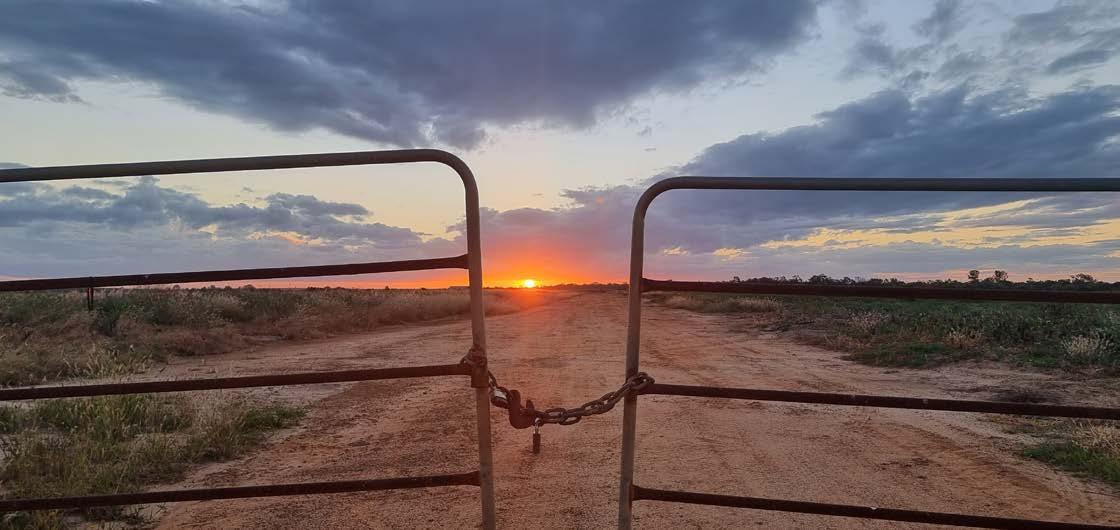
“This is about including men, women and children in the discussion early to ensure agribusiness viability and everyone’s wellbeing and financial security.”
During the road-testing of the resource growers and agribusiness women said they felt a real connection with the case studies provided, they revealed that it was like reading their family story.
“Financial security underpins a happy workplace. The most important thing is to start early with succession and keep the communication lines open.”
“Transitioning the family farm or succession is very real and I have seen the direct impact to family breakdown, the mental health of family members and associated business viability. This is why I got involved in this project – surely we can do it better and support people through the process,” Ms Williams said.
“I have seen many examples over the years of families and their agribusiness irrevocably damaged without transition/ destroyed without succession plans in place or even having open discussions with everyone involved.
“It’s important to have clarity around these subjects with all members of the family business that are affected, early on and use the resources available, to find clarity and direction for the next generation especially of a death or sickness in the family occurs.

“It’s timely as transitioning the family farm and succession planning is imperative for the cane industry.”
Because rural businesses are often family run farms, sometimes the need to treat the business as a business can be lost in the emotions arising amongst family members.
There is increasing recognition that emotional disputes can risk the financial sustainability and the future of the enterprise. Obtaining legal advice is imperative to successful transitioning and succession as it’s important to know what you don’t know.
It is hoped that resources like the QFF Walking the Wire e-kit can provide a safety net for growers helping them to recognise the value of open conversations about succession, seek professional advice to provide a sustainable future for their enterprises without damaging family relationships.
The QFF discussion paper The Financial Security of Farm Businesswomen in Australia by Max Broad identified four key problems that women in farm businesses often face:
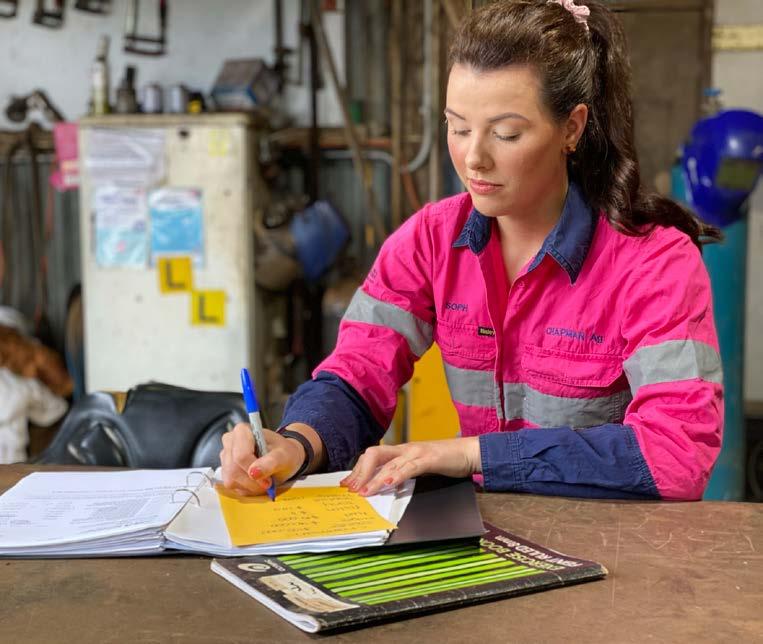
• unpaid work and the absorption of off-farm income to pay farm expenses, often results in lack of superannuation or off-farm income streams or investment.
• exclusion from financial decision making (often due to mistrust of inlaws, undervaluing contributions to the business). May result in lack of superannuation and exclusion from decisions related to farm transition.
• external factors that can limit a woman's choices and access to opportunities or that disincentivise the use of certain business structures or financial products.
• access to sound financial and succession planning advice and support can be costly or hard to access.
For more information about the QFF Walking the Wire e-kit follow the website link or scan the QR code below: www.qff.org.au/resources
"I have seen many examples over the years of families and their agribusiness destroyed without succession plans."
The clock is ticking for farmers and the agriculture industry to embrace NetZero targets. As early as 2023, farmers will face taxes when exporting to international markets if they do not adhere to cutting down their emissions. On home soil, corporations such as large supermarket retailers, Coles and Woolworths, have targets in place themselves to transition to NetZero and they will expect their suppliers to do so also.
Starting your journey to NetZero does not need to be difficult or need to happen all at once. At Horan & Bird, we will complete an on-farm energy analysis and will create a renewable energy solution plan that will not only save you money today, but will reduce your carbon footprint and will help you transition to NetZero Energy. This step-by-step NetZero Energy plan will set your farm up for the future and will mitigate against any future energy price increases.
Alinta Energy chief executive, Jeff Dimery, recently told the AFR’s Energy and Climate Summit that they are projecting, based on current market prices, that energy prices could increase by minimum 35% . This dramatic increase could mean your farm’s energy bill increases by hundreds of thousands of dollars each year.
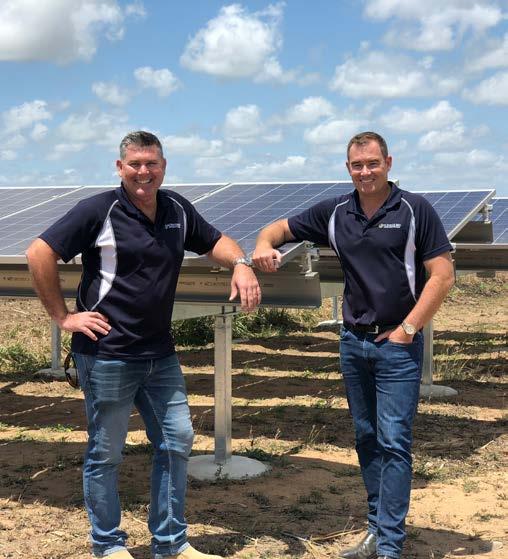
Prioritising greener electricity through renewable energy sources will be key as we face volatility and uncertainty in the current energy market. Being a cane grower using renewable energy, you can become your own energy provider and take control of your energy needs again.

Future proof your farm and start the NetZero Journey today with Horan & Bird.
We fund, design, build, own and manage the system.
You simply get the benefits of
Smartcane BMP accreditation is achieved by meeting or exceeding industry standards (verified through 3rd party auditing) in the program’s three core modules – Soil health and nutrient management, Irrigation and drainage management and Weed, pest and disease management. We have featured the three core modules in the recent Australian Canegrower magazines (Aug, Sep, Oct). However, you don’t have to go to audit to benchmark your business in any of the Smartcane BMP modules.
Any grower, registered with Smartcane BMP, can access the self-assessments for modules 1-8 (core and non-core) enabling them to benchmark their on-farm practices against industry standards.

Let’s take a look at modules 4-8.
Planting success has a major effect on farm profitability for the subsequent 4–5 years. This module covers the industry best practice for planting, including choosing the variety of cane and using clean seed. The module also covers efficient harvesting—many growers are requesting their harvest contractors to vary the harvester set-up and speed to reduce harvest loss and minimise effects on crop regrowth.
• Farm Map
• Farm Design
• Variety Management
• Clean Planting Material
• Billet Quality for Planting
• Time of Planting
• Planting
• Loss Minimisation
• Minimising Stool Damage at Harvest
• Block Selection for Harvesting
Knowing how your business is performing, and which factors are driving your profits, reduces the amount of guesswork around cashflow, profitability and your cost of production. This module covers business performance, succession planning and goal setting.
• Legal Obligations and Clear Title to Resources
• Business Goals and Plans
• Financial Risk Management
• Succession Planning
• Monitoring Production and Quality of Cane

• Business and Financial Records
• Cash Flow and Business Analysis
• Business Decision-making
• Investment in Research and Extension
• Labour ManagementObligations and Systems
• Employee Training, Learning and Networking
• Employee Roles and Responsibilities
Most farms have wetlands, waterways or riparian zones which are critical to the farm’s surface drainage. Some farms also have patches of native vegetation. This module covers ways you can protect the natural systems on your land and how these systems can make contributions to conserving native species.
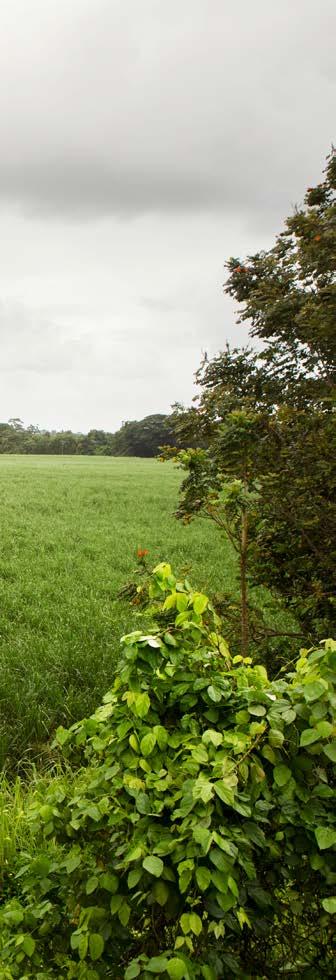
• Mapping and Recognising Natural Features
• Levees, Bunds and Crossings
• Retaining and Connecting Native Vegetation
• Enhancing Habitat Value of Natural Features
As a business owner, you have legal obligations to minimise the risks you and your workers are exposed to. This module covers these obligations so you know the documentation and processes you need to have in place. And there are many useful resources to help you ensure the risk of injury on your farm is kept as low as possible.

• Awareness of Workplace Health and Safety
• Risk Management
• Consultation
• Training and Supervision
• Worker Induction and Records
• Visitor Induction
• Emergency Response Plans
• Remote or Isolated Work
• Child Safety
• First Aid Kits and Provision
• Personal Protective Equipment
• Environmental Hazards
• Incident Reporting
This module provides accredited growers with the additional criteria required by global sustainability standards. This module covers the labour management, workplace health and safety and environmental factors you’ll need.
• Business Analysis
• Legal Obligations and Clear Title Resources
• Monitoring Production and Quality of Cane
• Investment in Research Extension
• Labour Management Obligations and Systems
• Employee Training, Learning and Networking
• Risk Management
• Training and Supervision
• First Aid Kits and Provision
• Personal Protective Equipment
• Incident Reporting
• Access to Drinking Water
• Risks to Natural Resources and the Environment
• Greenfield Expansions and Other Major Projects
• Monitoring Greenhouse Gas, Acid Rain Emissions and Primary Energy Efficiency

The CANEGROWERS Business Essentials program is utilising the self-assessments for modules 1,2,3,5 and 7 to assist program participants to benchmark their on-farm practices in relation to building and maintaining business resilience. The Business Essentials program looks at business risk due to climate, markets and management (including succession planning and workplace health and safety).
Burn Ashburner says “If you are meeting industry Best Management Practice standards, your business is well down the road of being as resilient as it can be. Growers who have undertaken the self-assessment/benchmarking process for non-core modules have used the information to identify issues that need to be addressed to create action plans and risk assessments for their businesses.“

Smartcane BMP has modules that cover all aspects of the cane farming business. It includes the option to become accredited in the farming practice modules (Modules 1, 2 and 3). Participation is entirely voluntary, and your facilitator can discuss what’s involved and put you in touch with local growers who are also part of the program. Contact your district facilitator to get involved.
Learn more about each of the modules by visiting the Smartcane.com.au/modules
After 17 weeks of crushing (15/10) Mossman Mill had just under 63% of the crop processed. The overall estimate is holding at 98% of the original. The coastal districts of Daintree and Mossman have been the two areas where the crop is starting to fall away more quickly. FNM Pty Ltd has managed to procure a few additional truck drivers and ramped up road cane deliveries.
At the time of writing Mossman Mill had processed 482,480 tonnes of cane for a mill average CCS of 12.40. The coastal growers supplied 329,713 tonnes of cane for an average of
11.77CCS and Tableland growers supplied 152,767 tonnes of cane for an average of 13.76CCS. The coastal CCS results have been very disappointing and similar to the 2021 crushing. However given that it is another La Niña year, this is not so surprising.

The Bargaining Agents met for their catch-up meeting with the mill representatives on Tuesday 25 October, and another QSL Grower update was held in Mossman on Monday 10 October.
The last month has had perfect weather on the Tablelands which has had higher to cut estimates for the district and with most varieties of cane producing higher than 14 CCS. Both the Tableland and Mossman Mill have been crushing at a consistent rate, over the last few weeks.
Meetings have been held with the Mill and harvest groups to keep abreast of the everchanging standover cane for the Tableland growers, who supply Mossman Mill.
Mossman Mill has engaged the services of sub-contractor, who have supplied four prime movers and 12 drivers to assist with the transport of cane down to Mossman. This has aided in cane supply and hope that will reduce the risk of standover.
At the time of writing the weather is fine with the daytime temperatures on the increase. Ratoons are actively growing and for most, the planting is complete. However, in the southern end of the region some planting is still being achieved.
Both mills are performing well and if the favourable conditions continue, a mid to late November finish date should be met.
CANEGROWERS Cairns Region representatives recently met with Tony Perrett MP, State Shadow Minister for Agriculture. This visit allowed Tony to see harvesting, farming activities and some research operations. Feral pigs were also on the agenda with Glenn Anderson and others giving him a rundown on the damage being done and the huge loss to productivity.
Harvest week - 18
CCS to date - 11.80
The impact of rising input costs is being recognised with fertilising “slow” across the Innisfail district. Despite early wet-weather delays, planting is almost finished.
At the time of writing, South Johnstone factory is on track to conclude in the first week of December including an allowance of five days for wet weather.
The QCGO board and CEO Dan Galligan visited Tully this month to meet with the Tully CANEGROWERS board and growers (pictured)
The QCGO board enjoyed a tour of the area followed by a grower meeting at the Murray Upper Rural Fire Station.
The meeting was well attended by local growers and local leaders from SRA, Tully Cane Productivity Services and Tully Sugar Ltd.

The Tully district has now completed 67.32% of the 2022 Crush at the end of week 20.
The average CCS is 12.72 to date, with a current mill area yield of 100 tonnes/hectare. The season estimate remains at 2,900,000 tonnes.
Tonnes to date - 1,039,231 (69.05%)
So far this year, mill performance has been exceptional with minimal hours lost due to breakdowns.
CANEGROWERS Innisfail recently welcomed Renee Cluff to the team as our communications and project support officer, this role is part of the Cassowary Coast Reef Smart Farming project.
Tonnes to date - 1,943,158 (68.18%)
The Herbert River district has crushed approximately 3.15M tonnes up to the middle of Week 19 with CCS for the week so far at 12.2. Recent widespread rain has brought up to 80 mm to some parts of the district while other areas have seen less with 10-15mm being reported.
The Wilmar official crop estimate of 4.7M tonnes will be lifted to 4.8M. Mill reliability and capacity to crush
a tonnage of close to 5M tonnes is a significant issue in 2022 with CANEGROWERS Herbert River directors raising their serious concerns with Wilmar management recently.
A number of growers have been mentioning that there are much bigger than usual rat infestations in the remaining crop despite having applied baits in some cases.
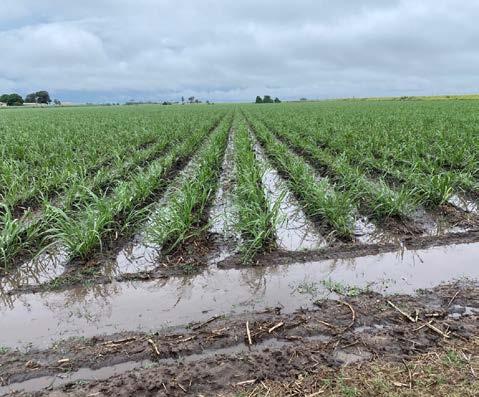

Mill Finish Week Ending Wet Days Included
Inkerman Mill 24/12/22 12.80
Invicta Mill 10/12/22 6.75
Kalamia Mill 17/12/22 8.00
Pioneer Mill 17/12/22 8.00
Invicta Mill continues to perform well and is putting in another very solid season so far. At the time of writing the district had delivered just over 70% of the crop and unfortunately rain had commenced to fall with some decent downpours being recorded ranging from 20mm to 150mm which brought crushing to a halt on 21 October. The rain was followed by some sunny and windy weather and Wilmar were keen to try and get their mills restarted within a week of the rain falling, however more rain was forecast which may change the duration of the stop. Prior to this downpour, the Burdekin had been very fortunate to miss out on a lot of the rain that was forecast over the last two months which enabled us to make some reasonable headway into getting the crop off after the lengthy July 2022 rain stop.
Whilst the rain would be welcome for plant cane, ratoons and mill maintenance, we simply didn’t want it as we were already weeks behind and there is still 30% of the crop remaining in the field. The fact that the district has now delivered 70% of the crop would be of relief to some growers who had forward sold an equivalent amount of their sugar and were concerned about not delivering their committed sugar due to possible wet weather impacts.
Season to date CCS of 14.09 remains behind budget due to the wet weather experienced prior to season commencement which lodged cane, followed by a cold winter of some duration and then rain in July. Whilst CCS has been recovering, we will wait to see what the impact of further wet weather has and any finish that has the month of December in it will not do the CCS any favours. Cane transfer continues from Pioneer, Kalamia and Inkerman to be crushed at Invicta, but unfortunately the transfer amount out of Kalamia and Inkerman Mill at 60 bins/day from each area is not going to make a material difference to the late finish.
CBL held a meeting with Local Member for Burdekin Dale Last to provide him an industry update on - 2022 season finish, water, electricity, sustainable sugar, Smartcane BMP, water quality monitoring and rising groundwater.
CBL participated in a meeting hosted by NQ Dry Tropics with a presentation from the independent consultant who is
compiling the 2022 Scientific Consensus Statement. This is an important report which will inform all technical aspects of Qld and Federal Governments policies and programs on Reef Water Quality. It is pleasing that an independent consultant has been appointed by the Government to undertake this report and the consultant has started from scratch with an emphasis on greater transparency.
The date for the CBL Annual General Meeting has been set for 30 November and further details will be provided in due course. We hope to see many of you there as it is a good opportunity to network with your fellow growers and to find out what is going on in both the local and wider industry.
Pictured: (below) CBL and local member Dale Last. Decent downpour in the Burdekin.
The Proserpine crop has been revised upwards from 1.7M tonnes to 1.78M tonnes – an increase of 4.7 percent on the previous estimate. The increase has been attributed to good in-season growth following favourable rain in the lead-up to the harvest.
Unfortunately, the bigger than expected crop is proving to be a serious challenge, while rain has caused its share of interruptions, poor milling performance has been the major contributor to lost time.
As a result the 2022 harvest is 240,000 tonnes, or roughly three weeks behind budget and current indications are the harvest will not be completed until late December.
As a result of the extended crushing period, and the forecast of more rain over the coming months, CANEGROWERS Proserpine has reduced the Collective’s interim payment CCS to 13.80.
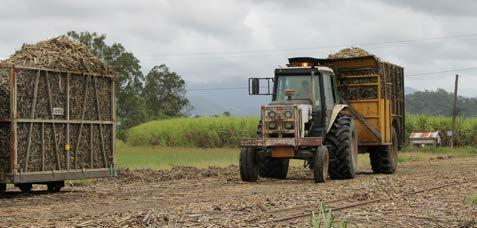
Season-to-date average CCS currently sits at 14.13 and has shown steady improvement over the last few weeks, however CCS has historically declined after October and the prospect of an early wet season will further impact the Collective Pool CCS.
CANEGROWERS will continue to monitor and, if necessary, make a further adjustment in November, this will be timed to coincide with the advance rate increase scheduled by the sugar marketers.
Both CANEGROWERS Proserpine and Sugar Services Proserpine will be hosting their AGMs on Friday 25 November (starting at 3:30pm) – members of both organisations are invited to attend.
Activity in Mackay is seeing members are focusing hard on racing the wet season to the end of crush.
Plane Creek milling area was delayed by showery/drizzly conditions in early October, bringing on a 16-hour stoppage of that mill. Wet paddock conditions hindered many harvesters, resulting in reduced supply to mill. At the time of writing, a stronger rain event was expected across Mackay and Plane Creek from 18 October.
Last month, Farleigh Mill presented challenging conditions for growers working hard to get their crop off, with repeated boiler issues halting operation intermittently from 6 October, and the focus (along with other maintenance activities) of a 60-hour shutdown from 17 October.
CANEGROWERS Mackay staff and grower representatives have participated in meetings with Queensland Hydro, whose interim CEO advised on the proposed pumped hydro Pioneer Burdekin Project. While there does not seem to be extensive impact on the upper Pioneer Valley’s sugarcane growing footprint, assurances were sought that there would be no impact on water allocations. QLD Hydro were informed that our priority was to see that any growers impacted by land resumptions for dam or power line utilities were cared for and properly compensated.
Sugar Terminals Ltd (STL) management visited our offices to update the board and staff on priorities for STL in Queensland’s sugar ports following completion of a major roof replacement program, and to discuss the state of play at Port of Mackay.
The development of a biofutures industry in the Mackay region continues to be of major interest, with Trade Commissioner - North America Viki Forrest along with Trade and Investment Queensland holding meetings with stakeholders, including CANEGROWERS Mackay CEO Kerry Latter. The outlook for the development of a significant “future foods”/plant-based protein manufacturing sector in this region is strong, with feedstock environmental credentials generated by the uptake of Smartcane BMP viewed positively by corporations operating in this cleangreen focused industry.
We remain committed to engaging with this emerging diversification for sugar cane, to ensure that benefits flow across the value chain, and particularly to growers. Any growers requiring assistance with any issues are encouraged to call 4944 2600. We also remind members needing to source harvest labour to get in touch in person or to make use of our electronic jobs board at www.mackaycanegrowers.com.au/farmers-notice-board
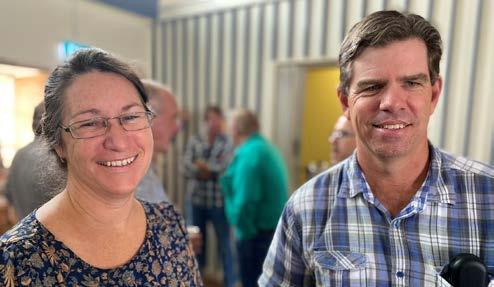
Bundaberg Sugar Mills processed 48,995.73 tonnes for the week ending 16 October, this brings the season to date to 681,085.34 tonnes. The average CCS for Bundaberg Sugar Mill for Week 18 was 14.24 CCS and the season CCS average for Bundaberg Sugar Mill is at 13.39 CCS.
The highest individual CCS for the week was 17.40 units for Q240 First Ratoon.
The weather has given us a break allowing most growers a chance to get some cane harvested and some field work done. In saying that, it is still quite wet in some fields and patchy showers of rain continue. This has seen some growers and harvesting contractors severely impacted.
Mill performance had been a little on the lack lustre side, but the past few weeks have seen a much needed increase in mill throughput and transport issues have settled down. Bundaberg CANEGROWERS has been in close negotiations
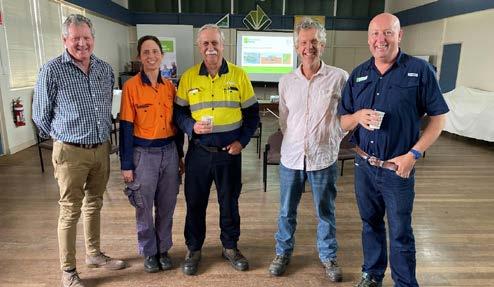
with the mill to help maximise mill throughput. CCS has been lower than average since the season began with the base CCS only just being achieved during Week 17. We are keeping a close watch on it with a real possibility of having to lower it.
QRIDA Flood Recovery Category C grant deadlines have been extended due to continued wet field conditions affecting the ability to complete earthworks and the constant struggle to find available contractors. Contact the office for updated deadlines or for assistance in completing your grant application.
With reef regulations coming into force from 1 December 2022, it is a timely reminder to gain advice on an N & P Budget for your farm. Matthew Leighton has been busy conducting soil tests and interpreting their findings, if you require assistance please contact Matt sooner rather than later to help avoid a last minute rush.
As this update is being written the rain is continuing to come steadily down across the district. Many growers are trying to get fertiliser on in really challenging conditions. The chances of getting the whole crop off in a timely manner is starting to look less likely. We have lost about 30 hours per week for the past five weeks due to wet weather which has meant the weekly throughput at Isis Mill has averaged around 57,000 tonnes. If this trend continues and the mill crushes throughout the Christmas period it would be mean a finish date of 2 January 2023.
We have recently met with representatives from the Office of the Great Barrier Reef and the Department of Environment and Science to discuss the introduction of the reef protection regulations which will come into effect on 1 December. We discussed:
• our frustration at not being able to access assistance to roll out the regulations unlike our northern colleagues
• the lack of a standardised industry format for crop nutrition, data recording and planning
• the multi-cropping landscape of our district and the challenges we face with mixed cropping
• the technical implementation of N and P Budgets
SRA hosted a Southern Regional Variety Committee Meeting where we heard from Dr Paul Carver, from New Energy Farms on the progress of the “artificial seeds” (CEEDs) technology being trialled at the Bundaberg Research Station. We hope to be able to view the progress of this trial at the SRA field day in late November.
CCS to date - 13.00
With week 18 completed we have passed the half-way point of the crop supply with a total of $340,138.90 tonnes supplied to 14 October.

This week has been under pressure from looming weather systems with wet conditions predicted from Friday 21 October. For an interesting reflection, it was almost the same time in October 2021 that we received too much rain and couldn’t operate for three weeks.
The AEG purchase of Maryborough Mill (pictured) continues to show incremental progress with confirmation of various equipment pieces being brought back to the site. Having recently visited the mill site on another matter, it is pleasing to see activity around the place.
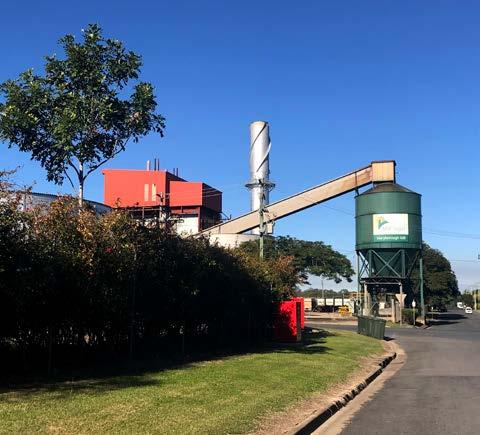
The arrangements for this season are the main focus and Isis Central Sugar Mill is keen to continue harvesting as long as possible. This could mean harvesting into early January and that will involve planning on a number of fronts. For example moving “over dimension” loads during the Christmas / New Year period require special permits if using major roads. These permits take time to both process and gain approval and would need to be understood by late November. The other obvious one is ensuring you have staffing for this period.
Rocky Point is due to start the 2022 harvest on Wednesday 19 October. With an estimated 360,000 tonnes of cane to get off, we are extremely concerned at the amount of cane we will not cut this year given that the harvest is starting very late. The long-range weather forecast for South East Queensland also raises concerns for all growers with many suffering financial stress due to the lack of cash flow.
Planting had ceased in the district due to the wet conditions and it is only just becoming dry enough for planting to resume.
The Fire Ant Suppression Team (“FAST”) at Biosecurity Queensland recently toured Rocky Point to get a feel for how bad the infestations are. They appear to have a greater appreciation for our plight and have indicated that they will come down and do some baiting as soon as possible.
The Valuation Objection process with the ValuerGeneral’s office is still ongoing, but we hope to have some sort of resolution very soon.
Tonnes to date - 340,138 (51.81%)
The mill and MSF are working through adjustments to Harvest Groups to keep everyone progressing as evenly as possible although access to dry ground is making this a difficult arrangement.
A joint government (Federal and Queensland) review of the Reef 2050 Water Quality Improvement Plan (Reef WQIP) is underway.
CANEGROWERS has long-standing concerns with the 2017-22 version of the Plan and continues to advocate strongly for the changes required if industry is to have confidence in the new plan and its implementation. The new plan must be practical, realistic, credible, and seek true win-win situations for the environment and growers.
The Reef WQIP includes several components of direct relevance to growers:
• Targets for water quality improvement for each river basin, for example a target for the percentage reduction in annual loads of dissolved inorganic nitrogen (DIN).
• Targets for further adoption of farm practices that improve water quality, for example targets for adoption of practices that will reduce DIN losses from farms.
• Government policies for achieving the practice adoption targets, for example voluntary adoption programs or regulation of farm practices.
The plan will be informed by a 5-yearly review of the science of water quality in catchments and the marine environment, which is published as a ‘Scientific Consensus Statement'. Progress towards targets is measured by the ‘Paddock to Reef’ program which relies on modelling the impacts on water quality of practice changes reported from Reef projects, such as those under the Reef Trust program.
All these components will be reviewed and updated over the next 12-18 months. However, the practice adoption targets in the 2017-22 Plan have been a particular concern for the sugarcane industry, as they require universal adoption of a suite of practices of variable or uncertain merit for growers. The apparent lack of progress towards these clearly unrealistic targets has been the basis of WQ report cards that are highly critical of growers.
The first step announced as part of the overall review of the Plan was a review of these adoption targets. We welcomed this independent review and participated in good faith - while some progress has been made, we are a long way from practical and credible recommendations that can be supported by industry.
► A joint government review of the Reef 2050 Water Quality Improvement Plan is underway.
► The new plan must be practical, realistic, credible, and seek true win-win situations for the environment and growers.

► Practice adoption targets in the 2017-22 Plan have been a particular concern for the sugarcane industry.
► CANEGROWERS will seek all opportunities to represent growers’ interests in the review of key components of the Reef WQIP.
Be this as it may, we remain committed to participating in this ongoing review to ensure the interests of growers are front and centre. We are advocating that practice adoption targets must be tailored to each district and developed in partnership with industry. This process can also provide a district-based roadmap for how any new government funding, e.g. from Reef Trust, should be invested.
CANEGROWERS will also seek all opportunities to represent growers’ interests in the review of other key components of the Reef WQIP. The Federal and Queensland governments have committed to providing such opportunities. This works in the interests of all parties.
Achieving further improvements in water quality, while maintaining productivity, will require real partnerships with growers, as they are the ones with the knowledge and experience to adopt and innovate practices best suited to the unique characteristics of their farms.
Further use of top-down approaches, where growers are often treated as passive participants rather than true partners, must be avoided.
On the face of it, it seems that nobody’s interests are served by extending the crushing season. There are neutral issues such as rain, miller issues such as unplanned breakdowns once it has started, and grower (harvester) issues such as poor payloads, all of which potentially increase the season length.
The cane payment formula pays the miller the first 4 units of CCS plus 10% of the rest, thus any decrease to the average CCS for the season is a cost to the mill, albeit much smaller than the cost to the grower.
Added to this is the cost of maintaining seasonal mill staff and loss of cane the next season. I am sure the miller will be able to expand on this, but the point is, the mill will face a cost if the season length is increased due to breakdowns.
On the face of it, it is not in the mills interest to have poor mill availability which extends the season length.
However, it seems for some mills this cost is outweighed by the saving in offseason maintenance costs and/or delaying capital replacement or upgrade of critical plant and equipment. This is a business decision the mills make considering their relative costs and risk.
The grower on the other hand has a definite and much greater cost, bearing 90% of the decreased average CCS, decreased growth for the next season with late cut cane, the risk of carry over and damage to fields if harvesting when wet.
The main point is that growers face the brunt of any season length increase. This is one of the issues growers’ (represented by CANEGROWERS) and millers have had to negotiate over the years. Most Cane Supply Agreements have a season length clause and CCS underwriting. As this is a negotiated position, it may not be ideal for growers.
It is hard to believe that there are any winners. From a growers perspective it is hard to understand why some mills feel it is worth taking the risk of a season length increase.
The harvesters (many of whom are growers) also face increased costs having to harvest the same amount of cane over a longer period with possibly an increased number of stops and starts and hence increased costs.
A further issue they face is potentially having to harvest over the Christmas curfew, which is the period between Christmas and New Year when oversize agricultural vehicles are not allowed access to state controlled roads.
To this end CANEGROWERS has met with the National Heavy Vehicle Regulator, the Department of Transport and Main Roads and the Queensland Police Service to clear the way to allow the crush to continue.

Operators who will need to access these roads during the curfew can apply for exemption permits which will be approved based on the merits of the application. The applications need to be received with sufficient time to allow them to be processed and will need to be fully completed with a comprehensive travel management plan.
► On the face of it, it seems that nobody’s interests are served by extending the crushing season.
► Any decrease to the average CCS for the season is a cost to the mill, albeit much smaller than the cost to the grower.
► However, it seems for some mills this cost is outweighed by the saving in off-season maintenance costs and/or delaying capital replacement.
► From a growers perspective it is hard to understand why some mills feel it is worth taking the risk of a season length increase.
Have you checked out the CANEGROWERS website or logged into the Members Resources section lately? There is a wealth of information about advocacy, products and services, as well as exclusive benefits for members.
Exclusive member benefits – deals, deals, deals! With interest rate rises, inflation and the cost of inputs all increasing, small savings all add up. CANEGROWERS offer a range of district wide benefits for our members.
Farm Supplies - BOC offers corporate pricing to CANEGROWERS members which applies to industrial gases, welding equipment, consumables and safety products. Growers just need to quote their CANEGROWERS membership number to access corporate pricing.
QFF farmer benefits - Through CANEGROWERS membership of the Queensland Farmers' Federation (QFF), all grower members are eligible for an extra range of services and support offered by QFF. This includes companies such as Bunnings Warehouse, AutoTender and Safe Ag Systems.
Mitsubishi Motors – National Fleet Discount to CANEGROWERS members
Through our membership with QFF, CANEGROWERS members are eligible to receive a National Fleet discount with Mitsubishi Diamond Advantage on the entire Mitsubishi Motors range of vehicles. For example, members can get 15% off the Mitsubishi Triton GLX Cab Chassis Double Cab.
To access this deal, visit your local Mitsubishi dealer, go to buyamitsubishi.com. au or call 1300911850 and let them know you’re a member of QFF through CANEGROWERS.
Health insurance - CANEGROWERS has partnered with Queensland Country Health Fund to offer members a Corporate Health Plan which offers a discount on annual premiums, coverage for health care anywhere in Australia with a choice of provider and a range of convenient ways to claim.
Exclusive information for members to support your business
CANEGROWERS Marketing Information Service - which offers education and information to members. It is an independent service which will not favour one marketer over another. There are weekly notes on market movements, a monthly video update and downloadable resources.
► With interest rate rises, inflation and the cost of inputs all increasing, small savings all add up. CANEGROWERS offer a range of district wide benefits for our members.
► Members are eligible to receive a National Fleet discount with Mitsubishi Diamond Advantage on the entire Mitsubishi Motors range.
► CANEGROWERS Marketing Information Service offers education and information to members on market movements.
► CANEGROWERS legal advisor Chris Cooper offers members access to legal advice.
Cost of Production Tool - an easy-to-use spreadsheet to help growers calculate their own cost of production. Knowing the cost of production and potential revenue will help growers make informed business decisions, set production and business goals to increase farm profitability. It can also assist with marketing and forward pricing decisions.
Workplace Health and Safety Guide for sugarcane farms - This is a tailor-made guide to the safe management of sugarcane growing processes. It is a starting point for growers to become aware of and compliant with legislative requirements, and provides guidance to help keep growers, their families, staff and visitors safe.
Transport/road access guides for farm equipment - CANEGROWERS has developed a range of resources for members needing to move farm vehicles and equipment on public roads. A handy checklist and decision-making tool along with district guides of critical and major roads is available to all members.
Legal – CANEGROWERS legal advisor Chris Cooper offers members access to legal advice and there is a list of useful articles on issues relevant to sugarcane growers including land valuation, succession planning and Native Title.
How to access these benefits? Go to the Member Resources page on the CANEGROWERS website www.canegrowers.com.au and enter your membership number or call your local CANEGROWERS office.

A group of 38 cane growers have collectively reduced their use of nitrogen by over 1,000 tonnes, beating their target by more than 15%, as part of a four-year program aimed at cutting inputs costs and reducing nitrogen losses into local waterways.
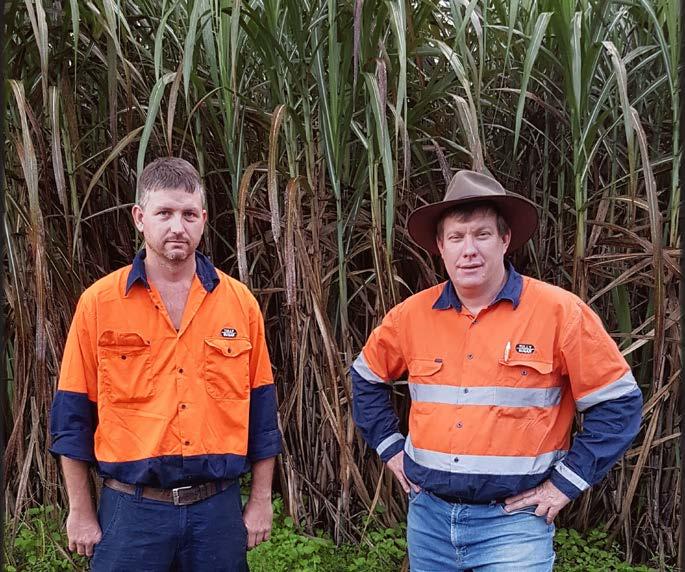
The growers from across the Wet Tropics took part in the Australian Government’s Reef Trust Repeated Tenders Program.
The program supported sugarcane growers to trial land management practices that would enable them to reduce their nitrogen fertiliser application rates without impacting yield, including following industry best practice guidelines on nitrogen use, the SIX EASY STEPS.
The growers implemented and trialled a wide range of practices from building soil health with cover crops, compost, and soil ameliorants, through to controlled traffic farming utilising GPS and soil mapping to closely match fertiliser inputs to crop requirements.
Trevor Parker, Project Coordinator at Terrain NRM, said the success of the Repeated Tenders program in reducing nitrogen use was due to growers being given the choice to trial practices and nitrogen application rates they considered most appropriate for their farms.
“Farmers are running business enterprises, so they need evidence before they make practice changes, and they also need the flexibility to decide what’s right for their particular farm” he said.
“The results from these trials are helping the industry to build knowledge about reducing N rates in different situations, which also helps growers save money. Collectively this group saved a total of approximately $1.3M through this program, which is a big saving.”
Greg Shannon, Cane and Productivity Manager at Tully Sugar Ltd, said that taking part in the project enabled the company to trial three organic-based biological products and soil ameliorants.
“We agreed to reduce our nitrogen rates by 15 kg N/ha on average using the SIX EASY STEPS best practice nutrient management toolbox.
"The results showed that yields were not affected by the reduced N inputs when coupled with the use of soil ameliorants. We think we can also reduce our N rates below 80 kg N/ha on fallow plant cane if we get a decent cover crop,” he said.
“There is always some risk involved with implementing new practices, so this program was an opportunity to trial ways to overcome the challenge of reducing N rates, while maintaining yields, and sharing lessons learnt with others so the whole industry can benefit.
“We were able to determine the ‘sweet spot’ for our N rates and the trials gave us the confidence to discount plant cane N rates on other farms we manage, when appropriate.”
Stewart Christie, Terrain NRM’s CEO said the Repeated Tenders program was popular with participants because it enabled growers to choose their own practice changes to suit individual farm conditions.
“The great thing about this project is that the Australian Government invested $4.7 million into backing growers to put their own ideas into practice.
"Farmers are natural problem solvers, so they have an important contribution to make in terms of finding solutions to poor water quality,” he said.
“The only way we will meet the Great Barrier Reef water quality improvement targets is through consistent long-term investment programs, which encourage new ideas and innovation, and shares the risk with farmers.
"This provides certainty, maintains momentum, and will enable us to accelerate progress towards the reef water quality improvement targets.”
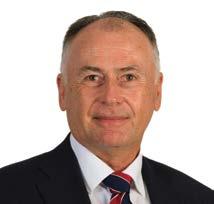
Growers are again reminded to take reasonable steps and precautions when having aerial chemical spraying undertaken on their cane farms.

In August this year two North Queensland tropical fruit growers launched legal proceedings in the Supreme Court against several businesses including a sugar cane grower.
The court claim is for more than $1m plus interest and costs and is based on claims of negligence and nuisance in carrying out aerial chemical spraying on the grower’s cane farms.
Those included as defendants in the proceedings are the spraying contractor, the owner of the plane, the seller of the chemicals and the grower whose farms were being sprayed.
The court case has only just begun and is likely to take some time before it is resolved. Fortunately for the grower he held comprehensive public liability insurance which included liability arising out of aerial spraying activity.
On this particular insurance policy there is a significant excess that may have to be paid but at least it seems the grower will largely be covered.
Apart from the claim itself there will be significant legal and associated fees in representing the grower and defending the claim which the insurer for the grower should cover.
This case is an important reminder that even though a grower might engage a contractor to carry out the spraying, the grower can still be caught up in legal proceedings if there is spray drift and damage suffered by a neighbour.
With suitable insurance cover though the very real financial impacts of being sued for a large sum of money can be managed.
The use of drones in agricultural activities is becoming increasingly popular. In some cases, drone operators are offering chemical spraying by drones.
Growers should be cautious though because many farm liability insurers are specifically excluding any insurance cover for spraying being undertaken by drones.
I would recommend checking with your proposed drone operator and also your own insurance underwriter/broker before any drone spraying takes place.
As the case above shows there is a risk of being sued. That risk is increasing in some districts that are experiencing the incursion of small cropping and other uses of traditional cane lands.
1. Application of chemicals is an important land and crop management tool for growers but it comes with risks of liability for offences and damages if it goes wrong.
2. It is beyond the scope of this article to discuss the safe use and application of chemicals. There is much information available from Biosecurity Queensland, and industry codes of practice and best management practice manuals. Chemical accreditation courses are also available.
3. Simply engaging a contractor to carry out spraying does not necessarily absolve the grower from responsibility and liability.
4. Always engage an experienced, licensed contractor who has proper insurance cover and fully brief them about any nearby susceptible crops.
5. Ensure the terms of the engagement of the contractor specify that you are relying on the contractor’s experience and qualifications and that the contractor is fully responsible for and must take all necessary steps to ensure the spraying is carried out safely and properly and in compliance with all relevant laws.
6. Understand and be aware of label instructions. Failure to comply with them is a strict liability offence with slim changes of successfully defending a properly brought prosecution.
7. If an incident does happen, seek advice and assistance promptly.
8. Always maintain comprehensive liability insurance, which includes aerial spraying liability if relevant.
9. Always err on the side of caution and responsibility when having spraying operations carried out.
10. Always maintain proper and detailed records about spraying activities and weather conditions.
11. Hold current chemical usage qualifications.
12. Keep a note of other spraying activities taking place near you.
1. Notify the neighbour and spraying contractor of your concerns.
2. Contact Biosecurity Queensland as soon as you suspect any damage might be suffered.
3. Contact your local CANEGROWERS Office and your local Growers Productivity Services company.
4. Make and keep detailed written records of all relevant fact and circumstances at the time, including weather conditions, date and time of spraying activity, details of any other persons spraying at the same time and crop and production records.
(This article contains general advice only. The particular facts and circumstances of each case always need to be taken into account)
Any CANEGROWERS member wishing to discuss any aspect of legal matters should contact their local CANEGROWERS district office or call me on Free Call 1800 177 159, for free initial legal advice.
The CANEGROWERS Queensland (QCGO) Board held its October meeting in Tully.
Aside from the business of a normal board meeting, the visit included an in depth discussion with the Tully Board, a farm visit, and a grower shed meeting where Chairman Owen Menkens and CEO Dan Galligan spoke to growers at length about the activities of CANEGROWERS.
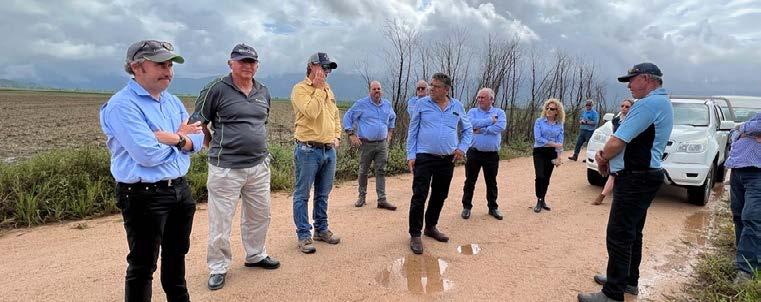
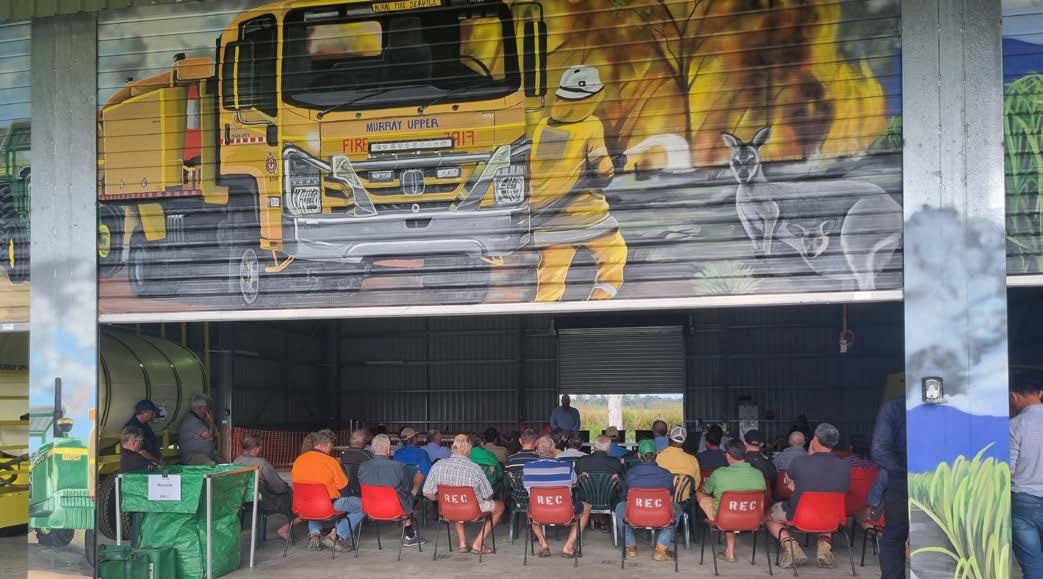
Importantly it provided an excellent opportunity for local growers and industry representatives to share their issues and priorities with directors from across the State.
The Board also took time to catch up with local directors, where Chairman Owen Menkens presented recently retired CANEGROWERS Tully manager Peter Lucy with an ornamental cane knife in recognition of more than 40 years of service to the industry.
Pictured: (top) QCGO grower meeting in Tully. (left top) CEO Dan Galligan, retired CANEGROWERS Tully Manager Peter Lucy, Chairman Owen Menkens, (left bottom) the QCGO Board visited Chris and Neville Condon's farm; (opposite page) CANEGROWERS Bord member Mark Mammino at the iconic Tully gum boot.


Making sure Queensland's cane growers get the best coverage was top of the agenda when the CANEGROWERS Insurance Business Unit met in the Burdekin recently with the Community Broker Network (CBN). The group travelled to CANEGROWERS Director Steve Pilla's farm to learn more about his harvest machinery and hear more about the automated irrigation systems. CBN staff enjoyed their tour of the grower’s farm which provided a hands-on look at our industry – a very different experience for the staff who are based in Newcastle and Melbourne.

After four and a half fruitful years with the Wet Tropics Management Authority’s Yellow Crazy Ant Eradication Program, Wesley Moller has decided to spend more time with his family on his Atherton Tableland cattle farm.
In his role as the Sugar Industry Liaison Officer, Wesley brought with him a lifetime of experience on the farm, at the Mulgrave Mill and on cane trains.
Wesley is well known and trusted by the local industry, because he knows the business.
Wesley’s close collaboration with all aspects of the sugar industry, particularly the Mulgrave Mill and cane farmers, has ensured the Authority is on track to find all the yellow crazy ant sites in cane areas and prevent any further spread.
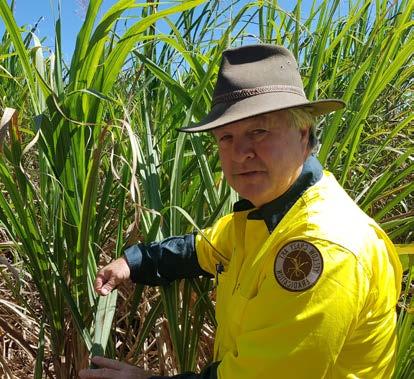
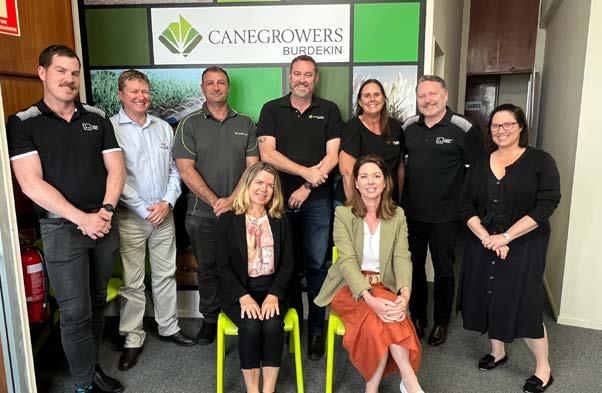
Wesley is justifiably proud of the Authority’s achievements and how well the sugar industry has adapted and contributed to help eradicate these ants.
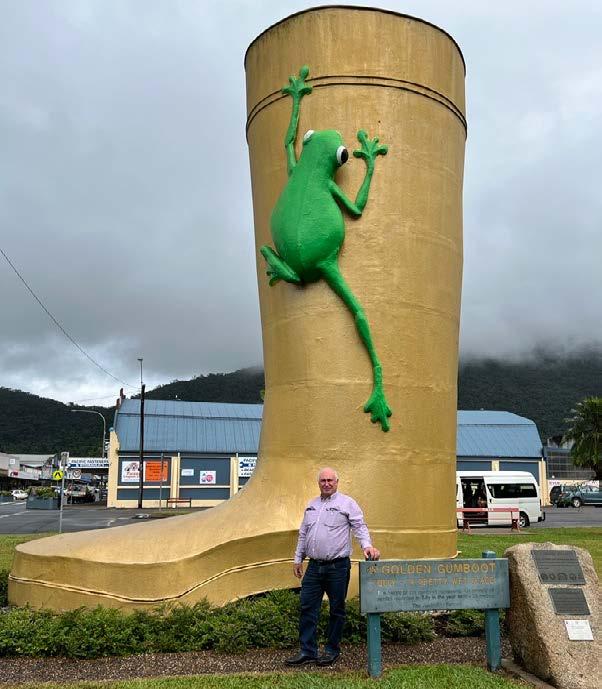
“We have shared our expertise and experience in developing innovative systems to minimise the risk of spreading yellow crazy ants”, Wesley said.
“Our achievements include detailed surveys and mapping of all known yellow crazy ant infestations, a traffic light system to ensure sugar harvesters did not move ants from existing infestations, and use of harvester data to trace movement of infestations over time”.
Wesley’s expertise and contributions have been vital to help achieve eradication. However, many challenges remain, and the Authority is looking for someone to carry on this good work.
If you are interested, or know someone else who might be suitable, please contact the Wet Tropics Management Authority on 07 4241 0525.
*
Australian
A charge of $5. 50 will apply for each extra line or part thereof. A charge will apply for advertising of non-cane growing activities. Advertisements must relate exclusively to cane farming activities, such as farm machinery, etc. Advertisements from nonmembers are charged at $11 per line incl GST. Only prepaid ads will be accepted.
2010 Austoft A8800 Cane Harvester, New Motor, 1800hrs, Walking Gear has done 1 Season, $120,000 inc. GST ono. Ph: 0407630499 or 0428453640.
6T Newton bulk fert bin $4000; Kubota L1500DT 4WD 4in1 bucket slasher/ back blade/single tyne ripper $7,000. Ph: 0402686714.
HBM Billet Plntr, single row adapt. to dual row, incl. 2x600L tanks; Tipper Bin (3x2T), Tipper Bin (2x2T); Toft 7000 HarvesterTotal $79,500 + GST - can separate. Ford 5000 $8,000 + GST. Ph: 0439852185 or 0448918422.
80" Howard Rotary Hoe & Ripper (New Blade) $4,000. 7 Tyne Grain Chisel $200. 2 x 20.8 38 8 Ply tyres reasonable condition $300 for both. Ph: 0438988858.
Fiat 980 2WD-3,500hrs, Fiat 1000 2WD – 5,000hrs, John Deere 4040 2WD –3,600hrs, Chamberlain JD 4080 2 WD – 5,000hrs,Case 2590 2WD – 5,700hrs, Michigan 110-14 Elevator Scraper-New engine & Spare engine, Massey Ferguson 3635 4WD – 5,500hrs, 6 tonne tipper bin, Silvan Euro Spand CX2 Spreader, Portable bulk bin, Bunning Lowlander Mk 40-60
Ag Spreader(near new), complete tracks to suit cane harvester, half tracks to suit cane harvester, and fuel trailer tank. Mulgrave area. Ph: 0407160673.
Toft 6000, CAT 3306DI, Rotary Chop, Bent elevator, standard topper. Good condition for age. Ph: 0740675327.
2x Ian Ritchie 6t side tippers. VGC. Ph: 0740562063.
2010 Case 8800 Cane Harvester Iveco Engine and all pumps. 2 seasons old. Machine in very good condition with GPS fitted chopper box fully overhauled. Cut 80,000 tonnes since complete overhaul. Ph: 0418337010. Tractor - 1988 Ford 7700 6720hrs, 2WD single remotes GC $12,000 + GST. Ph: 0407154250.
Farview Engineering 6 tonne side tipper. $11,000. Ph. 0407761364.
2 fan stripper $500, Moller single chain planter $4000, 1x Roberts 6T goose neck trailers $5000 ea, Grubber & box $300, Hodge upright planter $300. Ph after 7pm: 0408776366 or 0749591765.
Case 8800, 7300hrs engine full rebuild at 4500hrs. $180,000 negotiable. Ph: 0428588197.
96 cameco track harvester good condition. Approx 450hrs since engine was reconditioned. Come with Spare hubs. Tracks in good condition. Use as a plant cutter and back up harvester. Ph: 0400794857. Hodge, single row, bed renovator, heavy duty, as new $2,000 + GST. Ph: 0400889549.
Massey Ferguson 8110 4-wheel drive with cab, 135hp, only 2,636 hours in good condition. $55,000 incl. GST. Ph: 0438606578.
12t self-propelled 6x6 elev infielder. VGC. Mackay. Ph: 0438606578.
6t side tipper on Leyland tandem. GC. Mackay. Ph: 0438606578.
Don Mizzi 741 model on Fiat 750 special turbo plus MF102 half-tracks to suit. Mackay. Ph: 0438606578.
Celli Tiger spike hoe, 2.5m wide with hydraulic crumble roller and oil cooler. VGC. Mackay. Ph: 0438606578.
6t side tipper Ian Ritchie, Excellent condition $15,000 + GST. Ph: 0478719294.
2 row Bonnel fertiliser box with ground drive, 1¼ inch tynes$1,100 Ph: 0413584728.

Roller-bar Rake, always shedded, 2 new tyres, no further use. Reduced to $1,100 incl. GST. Ph: 0741213155.
Bonel 3 point linkage plant cane cutter with topper 1000 dollars plus GST. Ph: 0457447561.

HBM billet planter set up for dual row or single. $10,000. Twin 2.5 tonne billet planter tipper bin, carries 5 tonne $5,000. All + GST. Ph: 0413584728.
2019 John Deere 6175R,175 hp, 4WD, IVT Transmission, Starfire 6000 JD GPS, Front/ Cab suspension, Premium lights, 4 electric remotes, Front weights. 3600 hrs. UHF. Immac condition. Ph: 0419641518.
2012 Massey Ferguson 6465. Low 2,263 hours. Immaculate condition and service history. Located in the Condong grower area. $80k incl. GST. Ph: 0438428113.
Single row Hodge cutaway unit with discs and boards. Mackay area. Ph: 0438583130. 3 row cane cutaway unit. Preferably McLeod or Hodge but any brand considered. Mackay area. Ph: 0438583130.
WTB Fiat 750 special in good working order, must have 3PL, PTO and remotes. Ph: 0448742983. Ratoon roller. Ph Charles: 0418159998. Caterpillar d4 6u or d4 7u with blade. Running and operating would be good. Herbert region. Ph: 0404004371.
Looking for work, has a C Class Licence, Tractor ticket, has done 1 year Haul-out and 10 years farm tractor work, motor mechanic. Own transport, Innisfail area contact Mark on Markvolpe1964@gmail.com or 0432171030.
Cane farm 87 hectares - 215 acres at Como Road on Trebonne Creek, 5 minutes from the Ingham CBD. Includes a two bedroom cottage and farm shed. Contact Felix Reitano Real Estate on felix@reitano.com.au or 0747765007.
70ha Cane Farm with 61.5ha under cane. Located 8 km from town centre and 1 km from Victoria Mill. Property is flood free with town water supply running along property front. Paddocks have all been lasered and are well maintained and up to date with new varieties. Ph: 0427912277. Cane farm to lease Munburra, Sunnyside or Oakenden areas. Have own equipment. Ph: 0408011983.
840 meters opposite Moore Park Beach. Coastal Cane Farm 93 Acres and 146 megalitres of ground water. Large storage Shed. 1 x Diesel Irrigation pump for the underground irrigation. There are 2 fenced off areas, currently used for horses and cattle. No house on this property. Comes with crop. Ph Larry: 0418496864. Pleystowe cane farm. On 2 Lots. Approx 190 acres all up. Teemburra water, 2 pumps & licences, plus 32,000 gallons an hour underground bore. Machinery/irrigation shed. 2x 4" soft hose irrigators, farm lasered, underground main throughout. 2 sidings adjoin farms. Access to farm from Pleystowe School Rd & Formosa's Rd. Does not include
2021 crop. Selling due to health reasons. Ph: 0408733793.
Wanting to buy/lease cane farm in the Septimus area. Ph: 0417607722.
Wanting to buy/lease cane farm. Close to Racecourse mill, Tekowai, Alexandra areas. Ph: 0438545251.
Want to buy farm in the Mackay or Proserpine area. Must have two good condition houses and irrigation. Ph Paul: 0447545550.
WTB: Grazing & Irrigation Property. Grazing to run 300-500 head. 100 - 200acres irrigation. Located Sarina-Proserpine
Regions. Ph James: 0429621145.Wanting to lease - cane farm in the Walkerston/ Eton/Pleystowe areas and surrounds. Ph: 0421520331.
Young grower wanting to expand. Looking for farms to lease. Mulgrave Area. Ph: 0431036229.
Location
Recorded rainfall (mm) Average rainfall (mm) Month prior (Sep 2022) Month to date (1 Oct-24 Oct) Year to date Jan–Oct
Whyanbeel Valley (Mossman) 57.6 79 2662.8 2487.5
Mareeba Airport 30.4 20.2 781.4 698.7
Cairns Aero 25.8 81 1681.6 1734.6
Mt Sophia 32 119 3486 2940.2
Babinda Post Office 0 0 3611.1 3770.3
Innisfail 79 75.2 3037.2 3127.6
Tully Sugar Mill 76.5 95.6 3277.4 3635.7
Cardwell Marine Pde 30.4 114.9 1549.1 1806.5
Lucinda Township 25.4 0 1725.8 1846.8
Ingham Composite 46.9 116.2 1681.6 1791.2
Abergowrie Alert 0 0 324 1194.8
Townsville Aero 21.2 29 1069.6 949.3
Ayr DPI Research Stn 23.6 49 884 791.5
Proserpine Airport 31.8 59.2 1149.2 1184.8 Mirani Mary Street 46.8 26.8 826.9 1175.4 Mackay MO 51.8 50.8 995 1299.2
Plane Creek Sugar Mill 48.6 52.4 1014.6 1434
Bundaberg Aero 46.2 227 1205.4 792
Childers South 59.6 138 1206.8 693.9 Maryborough 48.4 218.6 1230.6 932.2
Tewantin RSL Park 132.2 148.8 2389 1359.9
Eumundi - Crescent Rd 118.8 28.4 2326.2 1397
Nambour DPI - Hillside 119.8 167.4 2713 1529.4
Logan City Water Treatment Plant 106 112.2 1494.2 891.4
Murwillumbah Bray Park 157.4 122.8 1842.9 1311.4
Ballina Airport 222.6 246.2 2748.6 1518.6
New Italy (Woodburn) 158 184.6 2456.8 1138.4
Brought
Trust


